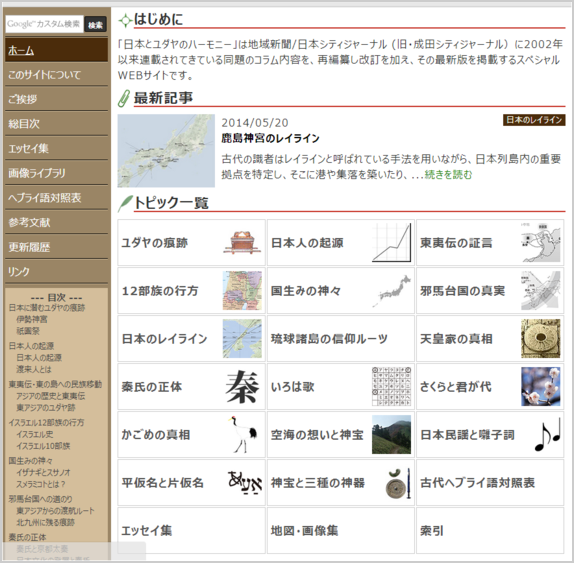One World
- God father of Japan 日本のゴッドファーザー
- の全文は"日本:古いから新しいまで"
- 何故カルトが蔓延するのか?
- 仏陀
世界は一つ
古代イスラエルと日本の神道
日本におけるユダヤ人の謎
The Mystery of Jews in Japan
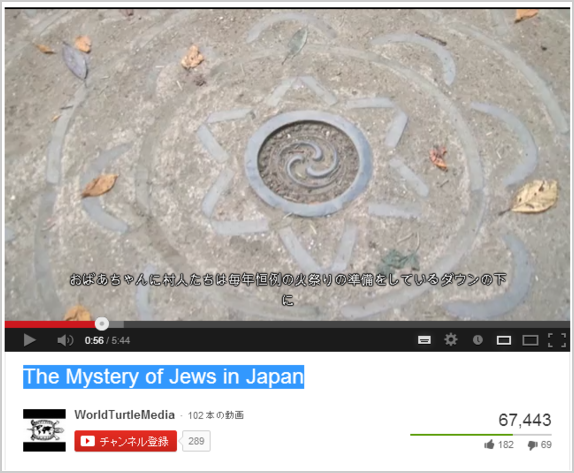
彼らはただ日本の原住民(千年前に中国から移住しなかったもの)上のDNAテストを行なったし、彼らはアフリカおよび中東のもので見られる類似のタンパク質を持っていることがわかった。
They just did a DNA test on the japanese natives (the ones that didn't immigrate from china a thousand years ago) and found that they have similar proteins that are found in those in africa and the middle east.
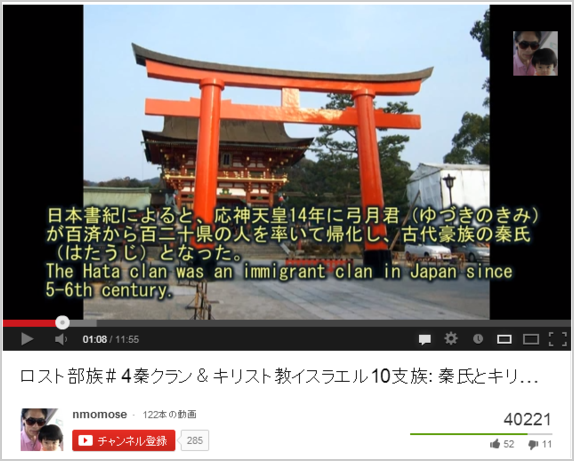
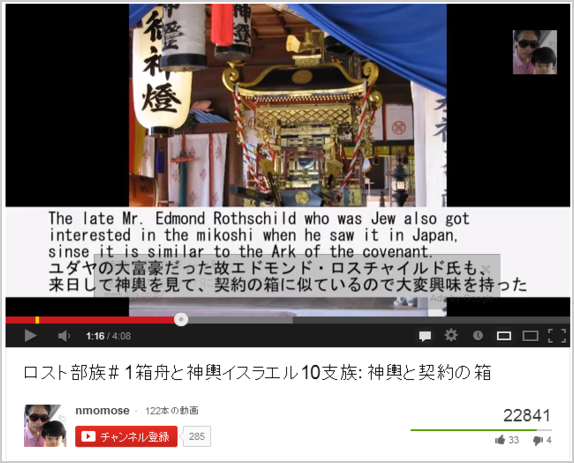
一般的なルールとして、ユダヤ教は、アクションや信念に焦点を当てる代わりに好んで、霊性の物理的な症状を拒否します。確かに、ユダヤ教の話があった偶像を粉々になった、古代の情報源によると、アブラハムから始まる ...
As a general rule, Judaism rejects physical manifestations of spirituality, preferring instead to focus on actions and beliefs.Indeed, the story of Judaism begins with Abraham who, according to ancient sources, shattered the idols that were the ...
イスラエル人は古代に来 日本
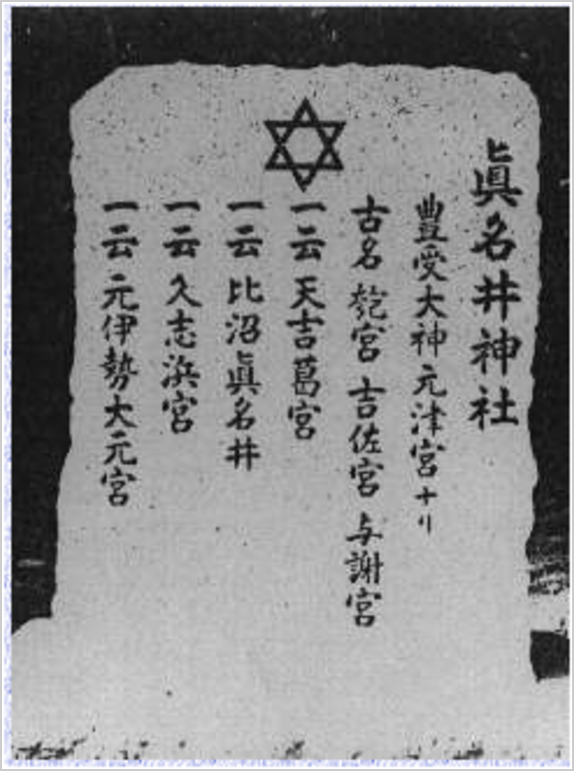
http://www.biblemysteries.com/library/tribesjapan.htm
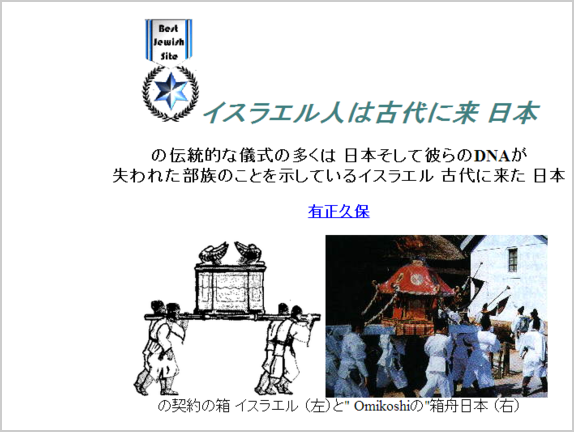
イスラエル人は、古代日本に来た
Israelites Came to Ancient Japan
伝統的な日本での儀式やそのDNAの多くは
イスラエルの失われた部族が古代日本に来たことを示している
Many of the traditional ceremonies in Japan and their DNA
indicate that the Lost Tribes of Israel came to ancient Japan
有正久保 / Arimasa Kubo
イスラエルの契約の箱(左)と、日本の" Omikoshi "箱舟(右)
Ark of the covenant of Israel (left) and "Omikoshi" ark of Japan (right)
世界で親愛なる友人、/ Dear friends in the world,
私は日本に住んで日本のキリスト教の作家です。私は聖書を勉強するように、私は古代イスラエルのものと非常によく似Japanareでその多くの伝統的な習慣や儀式を実現するために始めました。私は、おそらく、これらの儀式は、ユダヤ人の宗教や習慣から来て、古代の日本に来たかもしれないイスラエルの失われた十部族と考えた。
I am a Japanese Christian writer living in Japan. As I study the Bible, I began to realize that many traditional customs and ceremonies in Japanare very similar to the ones of ancient Israel. I considered that perhaps these rituals came from the religion and customs of the Jews and the Ten Lost Tribes of Israel who might have come to ancient Japan.
以下のセクションでは、おそらく古代イスラエル人由来のものがある日本の伝統に関心を持っています。
The following sections are concerned with those Japanese traditions which possibly originated from the ancient Israelites.
私はインターネット上でこれらを示す理由は、このテーマに興味がある人、特にユダヤ人の友人が興味になることを可能に自分自身でそれを研究し、あなたの結果を共有することです。
The reason why I exhibit these on the internet is to enable anyone interested in this subject, especially Jewish friends to become more interested, research it for yourself, and share your findings.
12部族から成っていたイスラエルの古代王国は933 BCEにあったイスラエルのJudahand北王国の南の王国に分かれています12のうち、 10部族は北王国と南王国に残りの部分に属していた。南部の王国からの子孫はユダヤと呼ばれています。北の王国の人々は722 BCEにアッシリアに追放されたそしてイスラエルに戻って来なかった。
The ancient kingdom of Israel, which consisted of 12 tribes, was in 933 B.C.E. divided into the southern kingdom of Judahand the northern kingdom of Israel. The 10 tribes out of 12 belonged to the northern kingdom and the rest to the southern kingdom. The descendants from the southern kingdom are called Jews. The people of the northern kingdom were exiled to Assyria in 722 B.C.E. and did not come back to Israel.
彼らは、 "イスラエルの失われた十部族"と呼ばれます。彼らは地球の四隅に散らばっていた。我々は、特にシルクロードに沿ってだけでなく、西側世界でイスラエルの子孫を見つけるだけでなく、東の世界である。以下の人々は、イスラエルの失われた十部族の子孫であることがユダヤ人の学者によって考えられている。
They are called "the Ten Lost Tribes of Israel." They were scattered to the four corners of the earth. We find the descendants of the Israelites not only in the western world, but also in the eastern world especially along the Silk Road. The following peoples are thought by Jewish scholars to be the descendants of the Ten Lost Tribes of Israel.
Yusufzai
彼らはアフガニスタンに住んでいます。 Yusufzaiはヨセフの子を意味する。彼らは古代イスラエル人の習慣を持っている。
Yusufzai
They live in Afghanistan. Yusufzai means children of Joseph. They have customs of ancient Israelites.
Pathans
彼らは、アフガニスタンとパキスタンに住んでいます。彼らは、 8日目に割礼の習慣、ローブの縞、安息日、カシュルート、 Tefilinなどを持っている
Pathans
They live in Afghanistan and Pakistan. They have the customs of circumcision on the 8th day, fringes of robe, Sabbath, Kashrut, Tefilin, etc.
カシミールの人々
カシミールで、彼らは、イスラエルの古代王国北部にあった同じ土地の名前を持っている。彼らは、過越の祭と、彼らはイスラエルから来たという伝説を持っている。
Kashmiri people
In Kashmir they have the same land names as were in the ancient northern kingdom of Israel. They have the feast of Passover and the legend that they came from Israel.
Knanites
インドではカナンの人々を意味Knanites 、呼ばれる人々がいる。彼らは、アラム語を話すとアラム語聖書を使用しています。
Knanites
In India there are people called Knanites, which means people of Canaan. They speak Aramaic and use the Aramaic Bible.
Shinlung族(ブネイMenasheの)
ミャンマー(ビルマ) 、インドライブShinlung族で、またMenasheの部族と呼ばれる。 Menasheのはマナセあり、 Menasheの族がマナセ、イスラエルの失われた十部族の一つの部族からの子孫であると言われている。彼らは、古代イスラエルの習慣を持っている。
Shinlung tribe (Bnei Menashe)
In Myanmar (Burma) and India live Shinlung tribe, also called Menashe tribe. Menashe is Manasseh, and the Menashe tribe is said to be the descendants from the tribe of Manasseh, one of the Ten Lost Tribes of Israel. They have ancient Israeli customs.
チェンマイ(強またはチェンマイミン)部族
彼らは中国に住んでいて、古代イスラエルの習慣を持っている。彼らは唯一の神を信じて、彼らは遠く西から来たことを昔からの言い伝えがあります。彼らは、彼らの祖先は12人の息子を持っていたことを言う。彼らは、過越の習慣、精製、レビレート結婚など古代イスラエル人として持っている。
Chiang (Qiang or Chiang-Min) tribe
They live in China and have ancient Israeli customs. They believe in one God and have oral tradition that they came from far west. They say that their ancestor had 12 sons. They have customs of Passover, purification, levirate marriage, etc. as ancient Israelites.
開封、中国
それは、 BCEの時以来大ユダヤ人社会が存在していたことが知られている。
Kaifeng, China
It is known that there had been a large Jewish community since the time of B.C.E..
日本
私は、このウェブサイト上でこれを議論するつもりです。
Japan
I am going to discuss this on this website.
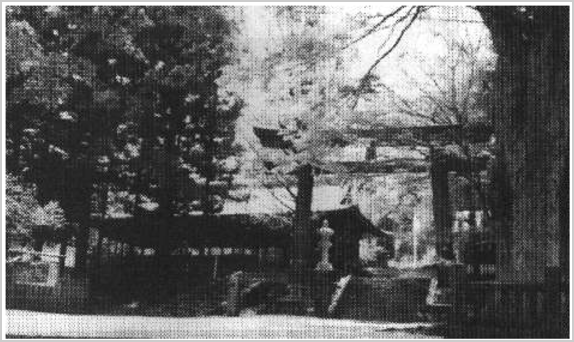
"諏訪大社"神社 / The "Suwa-Taisha" shrine
日本の祭りは、イサク(戦)の物語を示しています。
A Japanese Festival Illustrates the Story of Isaac.
長野県、日本では、"諏訪大社"という大きな神社があります(神道は、日本独特の国家の伝統的な宗教である。)
諏訪大社では、"Ontohsai"と呼ばれる伝統的な祭りは、(日本人は太陰暦を使用した場合、それは3月から4月であった)、毎年4月15日に開催されています。
In Nagano prefecture, Japan, there is a large Shinto shrine named "Suwa-Taisha" (Shinto is the national traditional religion peculiar to Japan.)
At Suwa-Taisha, the traditional festival called "Ontohsai" is held on April 15 every year (When the Japanese used the lunar calendar it was March-April).
この祭りでは、聖書の創世記の22章でアイザックの物語を示しています - アブラハムが自分の息子、イサクを犠牲にしようとしていたとき。古代の時代から開催された"Ontohsai"祭りは、最も重要な祭りであると判断される"諏訪大社"。
This festival illustrates the story of Isaac in chapter 22 of Genesis in the Bible - when Abraham was about to sacrifice his own son, Isaac. The "Ontohsai" festival, held since ancient days, is judged to be the most important festival of "Suwa-Taisha."
神社"諏訪大社"の後ろに山と呼ばれる山があります。守屋("守屋さん"日本語で)。諏訪地域から人々が富士山の神を呼び出します。守屋"守屋ない神"を意味し、"守屋の神。"この神社は、崇拝するように構築され、 "守屋の神。"
At the back of the shrine "Suwa-Taisha," there is a mountain called Mt. Moriya ("Moriya-san" in Japanese). The people from the Suwa area call the god of Mt. Moriya "Moriya no kami," which means, the "god of Moriya." This shrine is built to worship the "god of Moriya."
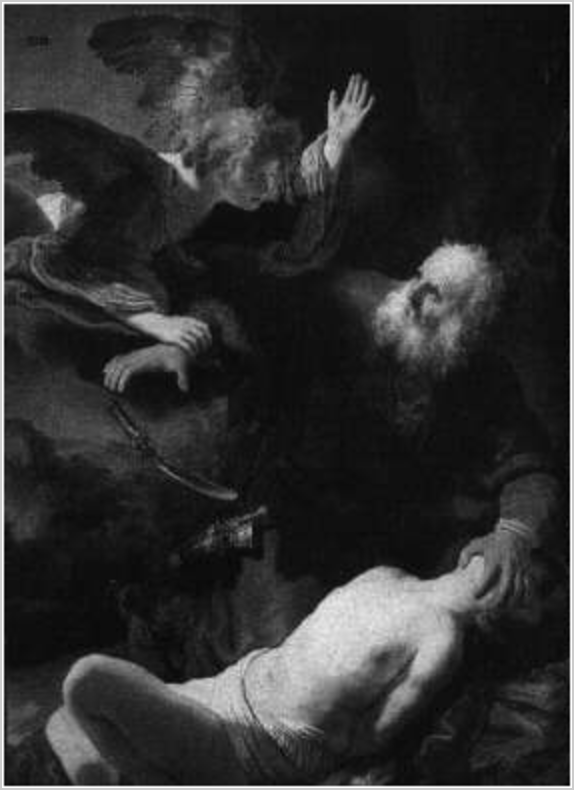
祭りでは、少年は木の柱にロープで縛られており、竹のカーペットの上に置いた。神主は、ナイフを準備し、彼に来て、彼は木製の柱の上部の一部をカットしたが、その後メッセンジャー(別の司祭)が来る、と少年は解放されます。これは、天使がアブラハムに来た後、アイザックがリリースされた聖書の物語を彷彿とさせる。
At the festival, a boy is tied up by a rope to a wooden pillar, and placed on a bamboo carpet. A Shinto priest comes to him preparing a knife, and he cuts a part of the top of the wooden pillar, but then a messenger (another priest) comes there, and the boy is released. This is reminiscent of the Biblical story in which Isaac was released after an angel came to Abraham.
この祭りでは、動物の犠牲も提供しています。 75鹿を屠殺し、それらの間でそれは、その耳分割の鹿があると考えられている。鹿が準備1神であると考えられている。それは、神が準備し、アイザックがリリースされた後に屠殺されたことのRAMを搭載した一部の接続があったかもしれない。ラムは角で茂みに巻き込まれたので、耳が分割されている可能性があります。
At this festival, animal sacrifices are also offered. 75 deer are sacrificed, but among them it is believed that there is a deer with its ear split. The deer is considered to be the one God prepared. It could have had some connection with the ram that God prepared and was sacrificed after Isaac was released. Since the ram was caught in the thicket by the horns, the ear might have been split.
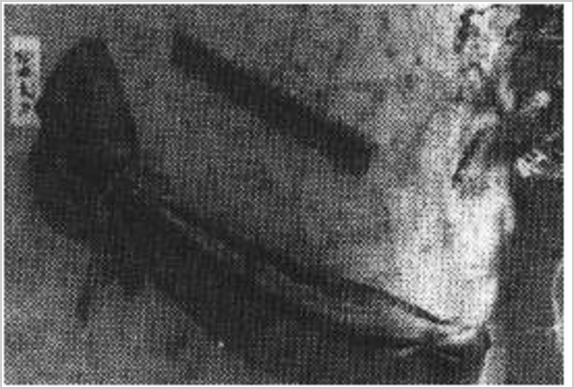
"Ontohsai"祭りで使用されるナイフと剣
The knife and sword used in the "Ontohsai" festival
日本の古代の時代にそこには羊がなかったし、それは彼らが(鹿はコーシャです)鹿を使用した理由かもしれません。でも、歴史的時代に、人々は動物の犠牲は神道の伝統ではないので鹿の犠牲のこの習慣は、不思議だと思いました。
In ancient time of Japan there were no sheep and it might be the reason why they used deer (deer is Kosher). Even in historic times, people thought that this custom of deer sacrifice was strange, because animal sacrifice is not a Shinto tradition.
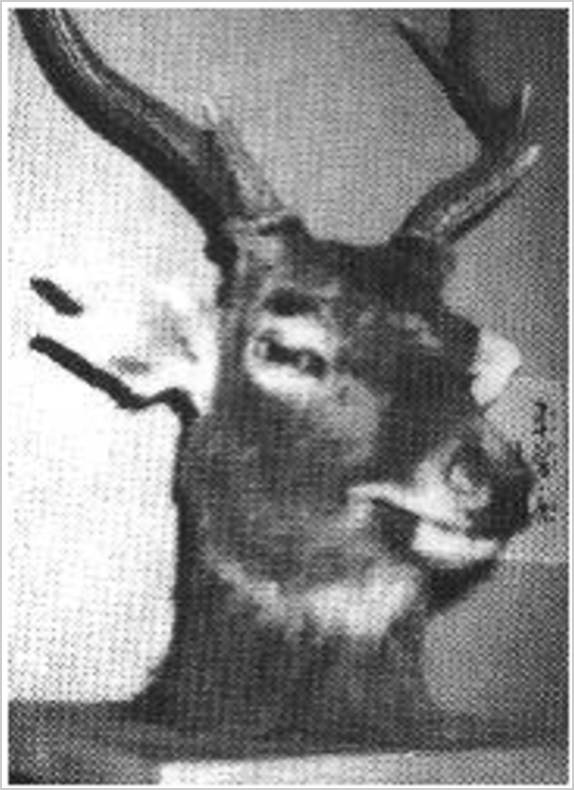
その耳を持つ鹿が分割 / A deer with its ears split
人々はこの祭り"Misakuchiの神のために祭"と呼んでいます。 "Misakuchi"は "MI-伊作カイ。"かもしれない"ミ"は "偉大な"、 "伊作は"(イツハク"、そしてカイ"は単語の終わりのために何かである可能性が最も高いアイザックヘブライ語)"である"ことを意味します。それは諏訪の人々は、おそらく偶像崇拝の影響により、イサクの神を作ったようだ。
People call this festival "the festival for Misakuchi-god". "Misakuchi" might be "mi-isaku-chi." "Mi" means "great," "isaku" is most likely Isaac (the Hebrew word "Yitzhak"), and "chi" is something for the end of the word. It seems that the people of Suwa made Isaac a god, probably by the influence of idol worshipers.
今日では、少年に屠殺した後解放されようと、この習慣は、もはや練習しないですが、我々はまだ "oniye-bashira、"、を意味すると呼ばれる木製の柱のカスタム見ることができる"犠牲ピラーを。"
Today, this custom of the boy about to be sacrificed and then released, is no longer practiced, but we can still see the custom of the wooden pillar called "oniye-bashira," which means, "sacrifice-pillar."
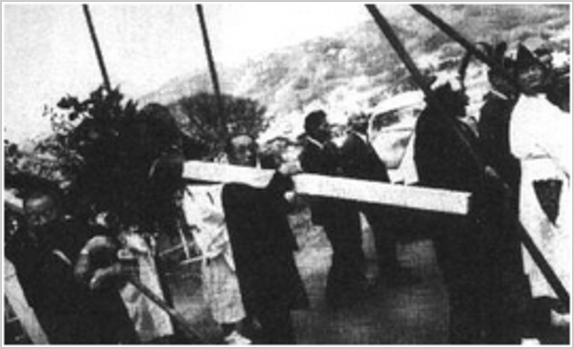
少年は縛られることになっている" oniye - bashira "
The "oniye-bashira" on which the boy is supposed to be tied up
現在、人々は、代わりに本物の動物の犠牲を行うのぬいぐるみを使用しています。動物の犠牲と一緒に少年を結ぶは明治時代(約100年前)の人々が野蛮と見なされていた、そしてその慣習は廃止された。しかし、祭り自体はまだ残っている。
Currently, people use stuffed animals instead of performing a real animal sacrifice. Tying a boy along with animal sacrifice was regarded as savage by people of the Meiji-era (about 100 years ago), and those customs were discontinued. However, the festival itself still remains.
少年の習慣は明治時代の初めまで維持されていた。 Edoera (約200年前)に日本の学者や旅行作家だった真澄Sugaeは、 、彼の旅の記録を書いた、彼は諏訪で見たものを指摘した。レコードには、の詳細を示し、 " Ontohsaiを。 "それは伝えその少年犠牲にされようとしていると彼の究極のリリースと同様に、当時存在していた動物の犠牲のカスタム。彼のレコードは、諏訪大社の近くに博物館で保存されています。
The custom of the boy had been maintained until the beginning of Meiji era. Masumi Sugae, who was a Japanese scholar and a travel writer in the Edoera (about 200 years ago), wrote a record of his travels and noted what he saw at Suwa. The record shows the details of "Ontohsai." It tells that the custom of the boy about to be sacrificed and his ultimate release, as well as animal sacrifices that existed those days. His records are kept at the museum near Suwa-Taisha.
" Ontohsai "のお祭りは、古代以来、守屋家によって維持されてきた。守屋ファミリーは彼らの祖先の神として"守屋-NO-神" (守屋の神)の考えている。彼らはまた、 "富士山。守屋"彼らの神聖な場所として検討してください。名前、 "守屋、 "エルサレムの今日の神殿の丘である創世記22時02分の"モリア" (ヘブライ語" Moriyyah " )から来ている可能性があります。ユダヤ人の中では、モリアの神は聖書が教えている唯一の真の神を意味している。
The festival of "Ontohsai" has been maintained by the Moriya family ever since ancient times. The Moriya family thinks of "Moriya-no-kami" (god of Moriya) as their ancestor's god. They also consider "Mt. Moriya" as their holy place. The name, "Moriya," could have come from "Moriah" (the Hebrew word "Moriyyah") of Genesis 22:2, that is today's Temple Mount of Jerusalem. Among Jews, God of Moriah means the one true God whom the Bible teaches.
守屋ファミリーは、 78代のためのお祭りを開催しています。と博物館の学芸員は、守谷市の神への信仰は、 BCEの時代から人々の間で存在していたことを私に言った。
The Moriya family has been hosting the festival for 78 generations. And the curator of the museum said to me that the faith in the god of Moriya had existed among the people since the time of B.C.E..
どうやら、他の国が、 Japanhasアブラハムとイサクの聖書の物語を説明するための祭り。この伝統は、古代イスラエル人が古代日本に来たという強力な証拠を提供するために表示されます。
Apparently, no other country but Japanhas a festival illustrating the biblical story of Abraham and Isaac. This tradition appears to provide strong evidence that the ancient Israelites came to ancient Japan.
JapanIsと同じの皇室の紋章は、エルサレムの門に見られる。
The Crest of the Imperial House of JapanIs the Same As That Found On the Gate of Jerusalem.
日本の皇室の紋章は、16枚の花弁の花の形をした丸いマークです。現在の形は菊(ママ)として表示されますが、学者たちは古代に、それはヒマワリに似て現れたと言う。ヒマワリの外観は、エルサレムのヘロデ門のマークと同じです。
The crest of the Imperial House of Japan is a round mark in the shape of a flower with 16 petals. The current shape appears as a chrysanthemum (mum), but scholars say that in ancient times, it appeared similar to a sunflower. The sunflower appearance is the same as the mark at Herod's gate in Jerusalem.
ヘロデ門に紋も16の花びらを持っています。日本の皇室のこのクレストは、非常に古くから存在していました。ヘロデ王のゲートでのものと同じマークが第二神殿のJerusalemfrom回の遺物で発見、また、紀元前の時代からアッシリアの遺物にされています。
The crest at Herod's gate also has 16 petals. This crest of the Imperial House of Japan has existed since very ancient times. The same mark as the one at Herod's gate is found on the relics of Jerusalemfrom the times of the Second Temple, and also on Assyrian relics from the times of B.C.E..
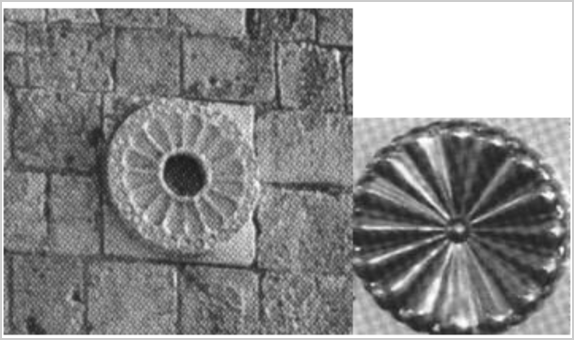
エルサレム(左)でのヘロデ門上のマークと、日本の皇室の紋章(右)
The mark on Herod's gate at Jerusalem (left) and the crest of the Imperial House of Japan (right)
日本の宗教司祭"は山伏は"ユダヤ人は彼らの額にフィラクテリーを入れて同じように彼らの額にブラックボックスを置きます。
Japanese Religious Priests "Yamabushi" Put A Black Box on their Foreheads Just As Jews Put A Phylactery on their Foreheads.
"山伏"は日本独自の研修で宗教的な人間である。今日では、それらは日本仏教に属すると考えられている。しかし、中国、韓国、インドの仏教は、そのような習慣を持っていません。仏教は、七世紀に日本に輸入される前の"山伏"の習慣は日本に存在していた。
"Yamabushi" is a religious man in training unique to Japan. Today, they are thought to belong to Japanese Buddhism. However, Buddhism in China, Korea and India has no such custom. The custom of "yamabushi" existed in Japan before Buddhism was imported into Japan in the seventh century.
の額に"山伏"と、彼は黒いひもで頭に結ばれている"トーキン"と呼ばれる黒い小箱を置きます。彼は非常に黒い紐が付いている彼の額にフィラクテリー(ブラックボックス)に入れてユダヤ人に似ています。このブラックボックス"トーキン"の大きさは、ユダヤ人のフィラクテリーとほぼ同じですが、その形状はラウンドと花のようです。
On the forehead of "Yamabushi," he puts a black small box called a "tokin", which is tied to his head with a black cord. He greatly resembles a Jew putting on a phylactery (black box) on his forehead with a black cord. The size of this black box "tokin" is almost the same as the Jewish phylactery, but its shape is round and flower-like.
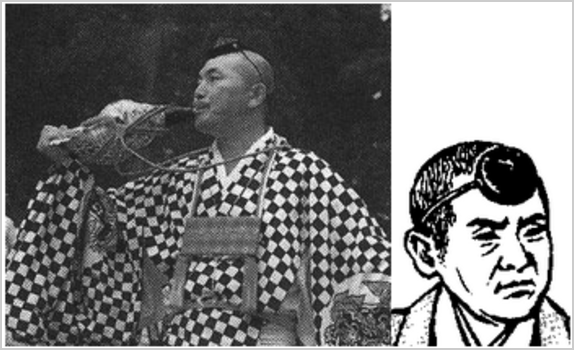
ホルンを吹いて"トーキン"で"山伏"
A "yamabushi" with a "tokin" blowing a horn
もともと額に置かユダヤフィラクテリーはコード(出エジプト記28:36-38)と大祭司アロンに置か額"プレート"から来ているようだ。これは、民間伝承によるとサイズは約4センチ(1.6インチ)で、一部の学者は、それが花の形であったと主張する。もしそうなら、それは "山伏"が着用和食 "トーキン"の形状に非常に類似していた。
Originally the Jewish phylactery placed on the forehead seems to have come from the forehead "plate" put on the high priest Aaron with a cord (Exodus 28:36-38). It was about 4 centimeters (1.6 inches) in size according to folklore, and some scholars maintain that it was flower-shaped. If so, it was very similar to the shape of the Japanese "tokin" worn by the "yamabushi".
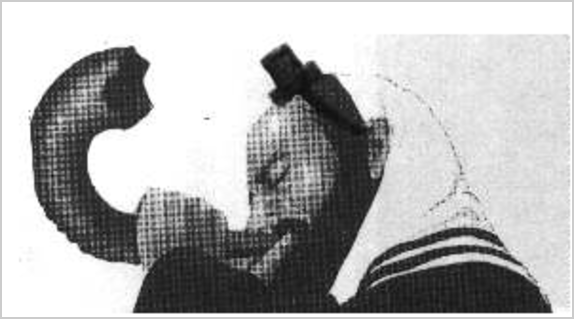
ショファルを吹いフィラクテリーとユダヤ人
A Jew with a phylactery blowing a shofar
イスラエルと日本は、世界で、私は宗教的な目的のために黒額ボックスの使用がの知っている唯一の二国です。
Israel and Japan are the only two countries that in the world I know of that use of the black forehead box for religious purpose.
さらに、 "山伏"はホーンとして大きな貝殻を使用しています。これはショファルまたはラムのホーンを吹いてユダヤ人に非常に似ています。方法は、それが溶断と "山伏の"ホーンの音がショファルのものと非常に類似しているされています。日本には羊がいないので、 "山伏"は雄羊の角の代わりに貝殻のホーンを使用する必要がありました。
Furthermore, the "yamabushi" use a big seashell as a horn. This is very similar to Jews blowing a shofar or ram's horn. The way it is blown and the sounds of the "yamabushi's" horn are very similar to those of a shofar. Because there are no sheep in Japan, the "yamabushi" had to use seashell horns instead of rams' horns.
" Yamabushis(山伏)は"宗教的な訓練のための彼らの聖地として山を考える人々である。イスラエルはまた、彼らの聖地として山見なす。律法の十戒は、富士山に与えられた。シナイ。エルサレムでは、山の都市です。イエス(イェシュア)祈るために山を登るために使用。彼の見かけの変容も山で発生しました。
"Yamabushis" are people who regard mountains as their holy places for religious training. The Israelites also regarded mountains as their holy places. The Ten Commandments of the Torah were given on Mt. Sinai. Jerusalem is a city on a mountain. Jesus (Yeshua) used to climb up the mountain to pray. His apparent transfiguration also occurred on a mountain.
日本では、山に住んでいると "山伏"の姿を持っている"天狗"の伝説があります。彼は顕著な鼻と超自然的能力を持っています。主君のために仕事をしながら、昔のエージェントまたはスパイだった"忍者"は、彼の超自然的な能力から取得するための山で"天狗"になります。
In Japan, there is the legend of "Tengu" who lives on a mountain and has the figure of a "yamabushi". He has a pronounced nose and supernatural capabilities. A "ninja", who was an agent or spy in the old days, while working for his lord, goes to "Tengu" at the mountain to get from him supernatural abilities.
"天狗"は彼に、追加の権限を与えた後、彼に"寅ノーまきを"( "虎"のスクロール)を与える。この"虎のスクロールは、 "任意の危機のために有用である非常に重要な本とみなされている。日本人は彼らの現在の生活の中で、時々この言葉を使用しています。
"Tengu" gives him a "tora-no-maki" (a scroll of the "tora") after giving him additional powers. This "scroll of the tora" is regarded as a very important book which is helpful for any crisis. Japanese use this word sometimes in their current lives.
知識は、ユダヤ人の律法の本当のスクロールが今まで日本の歴史的なサイトで発見されたことはありません。しかし、これは "虎のスクロール"ユダヤ人の律法の導出で表示されます。
There is no knowledge that a real scroll of a Jewish Torah was ever found in a Japanese historical site. However, it appears this "scroll of the tora" is a derivation of the Jewish Torah.
日本人" Omikoshi(お神興)は"契約の箱に似ている。
Japanese "Omikoshi" Resembles the Ark of the Covenant.
聖書では、まずクロニクルで、 15章には、ダビデがエルサレムに主の契約の箱を育てていること書かれています。
In the Bible, in First Chronicles, chapter 15, it is written that David brought up the ark of the covenant of the Lord into Jerusalem.
"ダビデとイスラエルの長老と千の単位の指揮官は、デイビッドが細かいのローブを着ていた....今喜びと、オベド·エドムの家から主の契約の箱を持って行きましたリネンは、箱舟を運ぶ、そしてとして合唱の歌を担当していた歌手、そしてKenaniahが、あったすべてのレビ人であったように。ダビデはまたリネンエポデを身に着けていた。だから全ての契約の箱をIsraelbrought雄羊の角とトランペットの響き、そしてシンバルの、そして琴やハープの演奏と叫びとともに主、 。 " ( 15:25-28 )
"David and the elders of Israel and the commanders of units of a thousand went to bring up the ark of the covenant of the LORD from the house of Obed-Edom, with rejoicing. ...Now David was clothed in a robe of fine linen, as were all the Levites who were carrying the ark, and as were the singers, and Kenaniah, who was in charge of the singing of the choirs. David also wore a linen ephod. So all Israelbrought up the ark of the covenant of the LORD with shouts, with the sounding of rams' horns and trumpets, and of cymbals, and the playing of lyres and harps." (15:25-28)
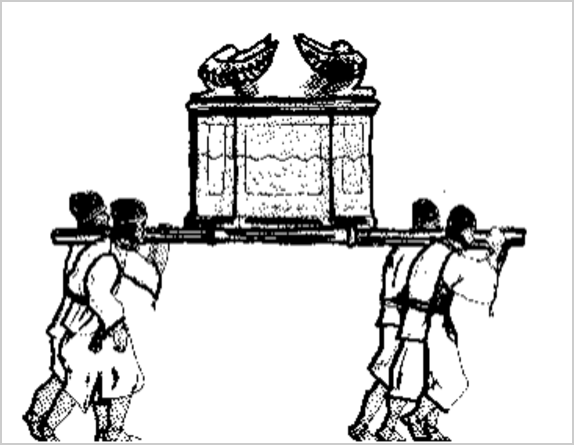
契約の箱を運ぶイスラエルの人々のイラスト
Illustration of Israeli people carrying the Ark of the Covenant
私は、これらの文章を読んだとき、私は思う。?"どのようによくお祭りの間に私達の'omikoshi'を運ぶ日本人のシーンのように、この外観はない日本の'Omikoshi'の形状は、契約の箱のように表示されます日本の歌とダンス。の叫びとそれの前、そして楽器の音に。これらは、古代イスラエルの習慣と非常によく似ています。"
When I read these passages, I think; "How well does this look like the scene of Japanese people carrying our 'omikoshi' during festivals? The shape of the Japanese 'Omikoshi' appears similar to the ark of the covenant. Japanese sing and dance in front of it with shouts, and to the sounds of musical instruments. These are quite similar to the customs of ancient Israel."
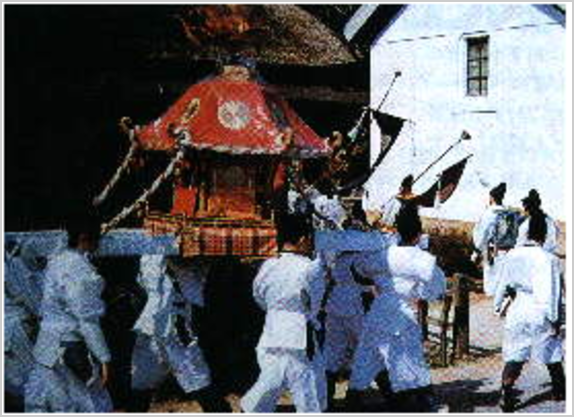
日本人" Omikoshi "箱舟
通常、2つの極 - 日本人は極との肩に" omikoshi "を運ぶ。だから、古代イスラエル人はなかった:
"モーセは主の言葉に従って命じられたようにレビ人は、彼らの肩の上に極をもつ神の箱を運んだ。 " ( 1クロニクル15:15 )
Japanese carry the "omikoshi" on their shoulders with poles - usually two poles. So did the ancient Israelites:
"The Levites carried the ark of God with poles on their shoulders, as Moses had commanded in accordance with the word of the LORD." (1 Chronicles 15:15)
契約のイスラエルの箱には、2つの極(出エジプト記25:10-15 )であった。
The Israeli ark of the covenant had two poles (Exodus 25:10-15).
それがあることが想像されたように箱舟の一部は復元されたモデルには、箱舟の上部にある2つの極を使用している。しかし、聖書は、これらの極が(出エジプト25:12 ) "その4つの足で" 4リングによって箱舟に固定することがあったと言います。したがって、極は箱舟の底に取り付けられている必要があります。これは日本に似ている" omikoshi 。 "
Some restored models of the ark as it was imagined to be have used two poles on the upper parts of the ark. But the Bible says those poles were to be fastened to the ark by the four rings "on its four feet" (Exodus 25:12). Hence, the poles must have been attached on the bottom of the ark. This is similar to the Japanese "omikoshi."
イスラエルの箱舟は、その上に金のケルビムの二像を持っていた。ケルビムは、天使の一種である、天国は、鳥のように翼を持っている。日本人" omikoshi "も架空の鳥と神秘的な天国の存在である"ホウオウ"と呼ばれ、その上部の金の鳥に与える。
The Israeli ark had two statues of gold cherubim on its top. Cherubim are a type of angel, heavenly being having wings like birds. Japanese "omikoshi" also have on its top the gold bird called "Ho-oh" which is an imaginary bird and a mysterious heavenly being.
全体イスラエルの箱舟は、金で重層した。日本人" omikoshi "も金で一部、時には完全にオーバーレイされます。 " omikoshi "の大きさは、イスラエルの箱とほぼ同じです。日本人" omikoshi "は古代イスラエルの箱舟の残骸である可能性があります。
The entire Israeli ark was overlaid with gold. Japanese "omikoshi" are also overlaid partly and sometimes entirely with gold. The size of an "omikoshi" is almost the same as the Israeli ark. Japanese "omikoshi" could be a remnant of the ark of ancient Israel.
箱舟に関する多くのものは、日本の税関に似ています。
Many Things Concerning the Ark Resemble Japanese Customs.
ダビデ王と人Israelsangのとは箱舟の前の楽器の音に合わせて踊った。私たちは、日本の歌と同様に" omikoshi "の前に楽器の音に合わせて踊る。
King David and people of Israelsang and danced to the sounds of musical instruments in front of the ark. We Japanese sing and dance to the sounds of musical instruments in front of "omikoshi" as well.
数年前、私はダビデ王の生涯を忠実に物語だった"ダビデ王"と題したアメリカ製の映画を見た。映画で、デビッドは、それがエルサレムに運ばれている間に箱舟の前で踊ってみました。私は考えた: " Jerusalemwereの風景は日本の風景に置き換えている場合、このシーンは日本のお祭りで観察することができるものとまったく同じになります。 "音楽の雰囲気も和風に似ています。 Davidさんの踊りは日本の伝統的な踊りのように表示されます。
Several years ago, I saw an American-made movie titled "King David" which was a faithful story of the life of King David. In the movie, David was seen dancing in front of the ark while it was being carried into Jerusalem. I thought: "If the scenery of Jerusalemwere replaced by Japanese scenery, this scene would be just the same as what can be observed in Japanese festivals." The atmosphere of the music also resembles the Japanese style. David's dancing appears similar to Japanese traditional dancing.
京都の"祇園神社"の神社のお祭りでは、男性は" omikoshi 、 "その後、川を入力し、それを越えて運ぶ。私は助けるが、これは彼らがエジプトからの脱出後にヨルダン川を渡ったように箱舟を運ぶ古代イスラエル人の記憶に由来すると考えることはできません。
At the Shinto shrine festival of "Gion-jinja" in Kyoto, men carry "omikoshi," then enter a river, and cross it. I can't help but think this originates from the memory of the Ancient Israelites carrying the ark as they crossed the Jordan river after their exodus from Egypt.
彼らが運ぶだろう前に瀬戸の瀬戸内海の日本の島では、 " omikoshi "のキャリアとして選択された男性は、一週間のために家で一緒に泊まる" omikoshiを。 "これは、自分自身を冒涜防ぐためです。それらが運ぶ前に、さらに日に" omikoshiを、 "男性は聖自身に海水で入浴。これは、古代イスラエルのカスタムのようになります。
In a Japanese island of the Inland Sea of Seto, the men selected as the carriers of the "omikoshi" stay together at a house for one week before they would carry the "omikoshi." This is to prevent profaning themselves. Furthermore on the day before they carry "omikoshi," the men bathe in seawater to sanctify themselves. This is similar to an ancient Israelite custom:
"だから、祭司とレビ人は、イスラエルの神、主の箱を持って自分自身を聖。 " ( 1クロニクル15:14 )
"So the priests and the Levites sanctified themselves to bring up the ark of the Lord God of Israel." (1 Chronicles 15:14)
聖書は、箱舟がエルサレムに入って行進が終了した後、 ( 1クロニクル16 "ダビデはみんなパン一斤、肉の部分、とレーズンのケーキに、イスラエル、男と女の両方のすべての人に配布"と言う: 3 ) 。これは日本の習慣に似ています。お菓子は日本のお祭りの後に全員に配布されます。それは私の幼少時の喜びだった。
The Bible says that after the ark entered Jerusalem and the march was finished, "David distributed to everyone of Israel, both man and woman, to everyone a loaf of bread, a piece of meat, and a cake of raisins" (1 Chronicles 16:3). This is similar to a Japanese custom. Sweets are distributed to everyone after a Japanese festival. It was a delight during my childhood.
日本人司祭のローブは、イスラエルの司祭のローブに似ている。
The Robe of Japanese Priests Resembles the Robe of Israeli Priests.
聖書は、ダビデがエルサレムに箱舟を育てたときに、 (1クロニクル15:27 ) "デイビッドは麻布の衣を着ていた"と述べている。同じことは、司祭と合唱のための本当だった。日本の聖書では、この詩はに翻訳され、 "白いリネンのローブ。 "
The Bible says that when David brought up the ark into Jerusalem, "David was clothed in a robe of fine linen" (1 Chronicles 15:27). The same was true for the priests and choirs. In the Japanese Bible, this verse is translated into "robe of white linen."
大祭司は、色鮮やかなローブを身に着けていたが、古代イスラエルでは、普通の祭司たちはシンプルな白いリネンを身に着けていた。祭司たちは聖なるイベントで白い服を着ていた。日本人司祭はまた神聖なイベントで白い衣を着用してください。
In ancient Israel, although the high priest wore a colorful robe, ordinary priests wore simple white linen. Priests wore white clothes at holy events. Japanese priests also wear white robes at holy events.
伊勢神宮、日本最古の神社のひとつで、司祭のすべてが白い衣を着用してください。彼らはイスラエル人がやったように" omikoshi "を運ぶ際に、特に多くの日本の神社、伝統的なもので、人々が白い衣を着用してください。
In Ise-jingu, one of the oldest Japanese shrines, all of the priests wear white robes. And in many Japanese Shinto shrines, especially traditional ones, the people wear white robes when they carry the "omikoshi" just like the Israelites did.
僧侶は、豪華多彩なローブを着用してください。しかし、日本の神道の宗教で、白は神聖な色とみなされている。
Buddhist priests wear luxurious colorful robes. However, in the Japanese Shinto religion, white is regarded as the holiest color.
日本の天皇は、彼が王位に彼の即位の儀式を終えた直後に、神道の神の前に一人で現れます。彼がそこに到着したとき、彼は彼の足が裸でいることを除いて、彼の体全体を覆っている純白のローブを身に着けている。これは、素足(出エジプト記3:05 、ジョシュア5時15分)になるように、神の前で自分のサンダルを削除モーセとヨシュアの行動に似ています。
The Emperor of Japan, just after he finishes the ceremony of his accession to the throne, appears alone in front of the Shinto god. When he arrives there, he wears a pure white robe covering his entire body except that his feet are naked. This is similar to the action of Moses and Joshua who removed their sandals in front of God to be in bare feet (Exodus 3:5, Joshua 5:15).
マーヴィントケイヤー、 10年間日本に住んでいたラビは、彼の本に書いた:
Marvin Tokayer, a rabbi who lived in Japan for 10 years, wrote in his book:
"日本の神道の祭司たちが着るリネンのローブは、イスラエルの古代の司祭の白いリネンのローブと同じ姿を持っている。 "
"The linen robes which Japanese Shinto priests wear have the same figure as the white linen robes of the ancient priests of Israel. "
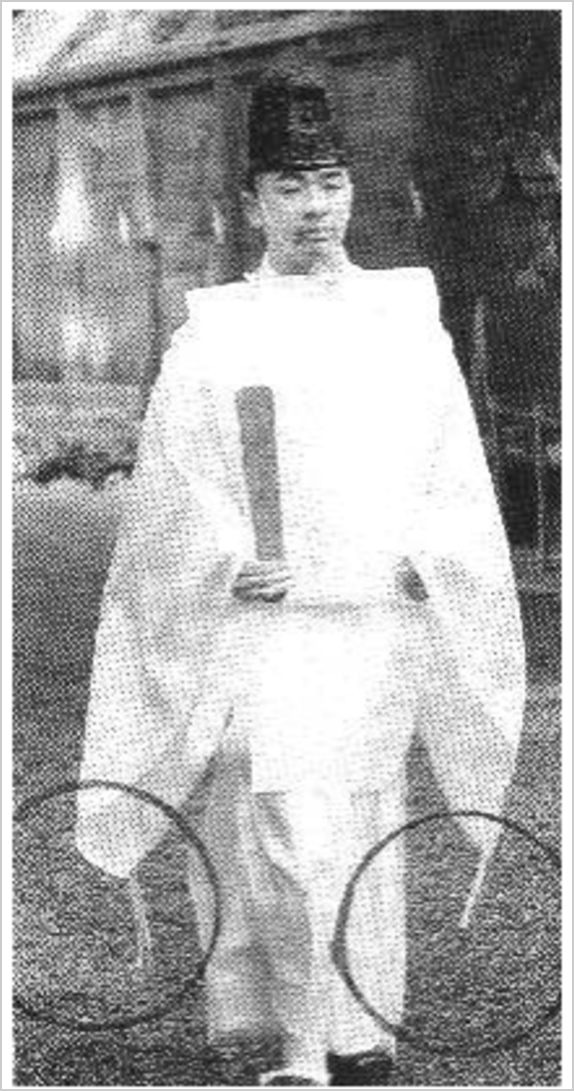
フリンジと白衣の日本神道の司祭
Japanese Shinto priest in white robe with fringes
日本の神道の司祭ローブはローブのコーナーからハング長い20〜30センチメートル(約10インチ)のコードを持っています。これらの縞は古代イスラエル人のものと似ています。申命記22時12分は言う:"彼らの世代を通して彼らの衣服の...コーナーで彼らに縞を作る。
The Japanese Shinto priest robe has cords of 20-30 centimeters long (about 10 inches) hung from the corners of the robe. These fringes are similar to those of the ancient Israelites. Deuteronomy 22:12 says:
"make them fringes in the... corners of their garments throughout their generations."
"フリンジ(房)は人はイスラエル人だったことトークンだった。新約聖書の福音書では、それはまた、 (マタイ23:05 )パリサイ人たちは、 "長い間彼らの衣服に自分の房を作る"ことが書かれています。出血に苦しんでいた女性が( :人の言語に翻訳、チャールズ·B ·ウィリアムズによって翻訳マシュー午前9時20分、新約聖書)イエス(イェシュア)に来て、 "彼のコートのタッセル"触れ。
Fringes (tassels) were a token that a person was an Israelite. In the gospels of the New Testament, it is also written that the Pharisees "make their tassels on their garments long" (Matthew 23:5). A woman who had been suffering from a hemorrhage came to Jesus (Yeshua) and touched the "tassel on His coat" (Matthew 9:20, The New Testament: A Translation in the Language of the People, translated by Charles B. Williams).
古代イスラエルの衣類の想像写真は時々縞を持っていません。しかし、彼らのローブは、実際には縞を持っていた。ユダヤ人はときに祈るに置くユダヤ人Tallit (祈りのショール)は、伝統によるとコーナーでの縞を持っています。
Imagined pictures of ancient Israeli clothing sometimes do not have fringes. But their robes actually had fringes. The Jewish Tallit (prayer shawl), which the Jews put on when they pray, has fringes in the corners according to tradition.
日本の神道の祭司たちは彼らのローブに太ももへ彼らの肩から布の長方形を着用してください。これはデイヴィッドが着用エポデと同じです。"ダビデはまたリネンエポデを身に着けていた。 " ( 1クロニクル午後03時27分)を
Japanese Shinto priests wear on their robe a rectangle of cloth from their shoulders to thighs. This is the same as the ephod worn by David:
"David also wore a linen ephod." (1 Chronicles 15:27)
大祭司のエポデは宝石でカラフルでしたが、彼の下普通の祭司たちはシンプルな白いリネンの布( 1サムエル午前22時18分)のephodsを身に着けていた。日本の神道の司祭のローブに布の長方形がKohen 、ユダヤ人の司祭のエポデと非常によく似ているラビトケイヤー状態。
Although the ephod of the high priest was colorful with jewels, the ordinary priests under him wore the ephods of simple white linen cloth (1 Samuel 22:18). Rabbi Tokayer states that the rectangle of cloth on the robe of Japanese Shinto priest looks very similar to the ephod of the Kohen, the Jewish priest.
日本の神道の司祭はやったイスラエルの司祭のように彼の頭の上にキャップ(出エジプト記29:40 )を置きます。日本人司祭はまた彼の腰にサッシを置きます。だからイスラエルの司祭はやった。日本の神道の司祭の服は、古代イスラエル人によって使用される衣類に似たように見えます。
The Japanese Shinto priest puts a cap on his head just like Israeli priest did (Exodus 29:40). The Japanese priest also puts a sash on his waist. So did the Israeli priest. The clothing of Japanese Shinto priests appears to be similar to the clothing used by ancient Israelites.
収穫の束を振ることも、日本のカスタムです。
Waving the Sheaf of Harvest Is Also the Custom of Japan.
ユダヤ人の波7週間シャブオット(ペンテコステ、レビ記23:10-11 )前穀物の彼らの最初の果実の束、また仮庵(ブースの饗宴、レビ記23時40 )で植物の束を振る。これは、モーセの時代からの伝統となっています。彼が誰かを聖別するとき、古代イスラエルの祭司たちはまた、植物の枝を振った。ダビデは"ヒソップで私をパージして、私はきれいにしなければならない"と述べた[詩篇51:7 ( 9 ) ] 。また、これは日本の伝統的な習慣である。
The Jews wave a sheaf of their first fruits of grain seven weeks before Shavuot (Pentecost, Leviticus 23:10-11), They also wave a sheaf of plants at Sukkot (the Feast of Booths, Leviticus 23:40). This has been a tradition since the time of Moses. Ancient Israeli priests also waved a plant branch when he sanctifies someone. David said, "Purge me with hyssop, and I shall be clean" [Psalm 51:7(9)]. This is also a traditional Japanese custom.

神聖化のために神主振る
Shinto priest waving for sanctification
日本人司祭が誰かか何かを神聖、彼は波の木の枝を。または彼波スティックとホワイトペーパーで作られており、植物のように見えている"harainusa、"。今日の"harainusa"は簡素化され、小さな稲妻のようにジグザグに折られているホワイトペーパーで作られたが、昔はそれは、植物の枝や穀物だったさ。
When a Japanese priest sanctifies someone or something, he waves a tree branch. Or he waves a "harainusa," which is made of a stick and white papers and looks like a plant. Today's "harainusa" is simplified and made of white papers that are folded in a zigzag pattern like small lightning bolts, but in old days it was a plant branch or cereals.
私の日本のクリスチャンの女性知人は単に異教徒カスタムとして"harainusa"を考えるために使用。しかし、彼女は後で仮庵式に出席する機会がありましたUSAandに行ってきました。彼女は収穫の束のユダヤ振っを見たとき、彼女は"ああ、これは日本の司祭が行う!ここに日本人のための家を嘘と同じです。"、彼女の心に叫んだ
A Japanese Christian woman acquaintance of mine used to think of this "harainusa" as merely a pagan custom. But she later went to the U.S.A.and had an opportunity to attend a Sukkot ceremony. When she saw the Jewish waving of the sheaf of the harvest, she shouted in her heart, "Oh, this is the same as a Japanese priest does! Here lies the home for the Japanese."
日本の神社の構造は、古代イスラエルの神の幕屋に似ています。
The Structure of the Japanese Shinto Shrine is Similar to God's Tabernacle of Ancient Israel.
神の幕屋の内部は古代Israelwasに2つの部分に分かれて。最初は聖所で、第二は、至聖所であった。日本の神社は、2つの部分に分かれています。
The inside of God's tabernacle in ancient Israelwas divided into two parts. The first was the Holy Place, and the second was the Holy of Holies. The Japanese Shinto shrine is also divided into two parts.
日本の神社で実行される機能は、イスラエルの幕屋と同様である。日本人はその聖所の前で祈る。彼らは、内部に入ることができません。唯一神道司祭と特殊なものが入ることができます。神主だけ特別回で日本人神社の至聖所に入る。これは、イスラエルの幕屋に似ています。
The functions performed in the Japanese shrine are similar to those of the Israeli tabernacle. Japanese pray in front of its Holy Place. They cannot enter inside. Only Shinto priests and special ones can enter. Shinto priest enters the Holy of Holies of the Japanese shrine only at special times. This is similar to the Israeli tabernacle.
至の日本聖は通常はるかに西または神社のはるか北に位置しています。至イスラエルの聖なるは寺の西端に位置していた。至神道の聖も聖所よりも高いレベルにあり、それらの間のステップがあるされています。学者の状態つまり、ソロモン、至聖所によって建てられたイスラエルの神殿でなく、上昇したレベルにあった、そしてそれらの間に、幅約2.7メートル(9フィート)のステップがありました。
The Japanese Holy of Holies is located usually in far west or far north of the shrine. The Israeli Holy of Holies was located in far west of the temple. Shinto's Holy of Holies is also located on a higher level than the Holy Place, and between them are steps. Scholars state that, in the Israeli temple built by Solomon, the Holy of Holies was on an elevated level as well, and between them there were steps of about 2.7 meters (9 feet) in width.
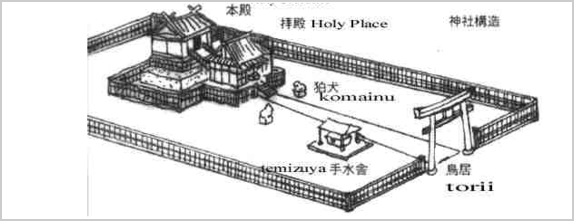
日本の神社の前には、アプローチの両側に座っている"狛犬"として知られているライオンの二像があります。彼らは偶像が、神社のために警備員ではありません。また、これは、古代イスラエルの習慣だった。イスラエルで、ソロモンの宮殿で神の神殿では、ライオンの像または軽減(1キングス午前7時36分、午前10時19分)がありました。
In front of a Japanese shrine, there are two statues of lions known as "komainu" that sit on both sides of the approach. They are not idols but guards for the shrine. This was also a custom of ancient Israel. In God's temple in Israel and in the palace of Solomon, there were statues or relieves of lions (1 Kings 7:36, 10:19).

神社は "狛犬"ガード / "Komainu" guards for shrine
日本の初期の歴史の中で、全くライオンはありませんでした。しかし、ライオンの像は、古来日本の神社に置かれています。それは、日本の神社の正面に位置ライオンの像が中東由来という学者によって証明されています。
In the early history of Japan, there were absolutely no lions. But the statues of lions have been placed in Japanese shrines since ancient times. It has been proven by scholars that statues of lions located in front of Japanese shrines originated from the Middle East.
彼らの手と口を洗浄するための参拝場所 - 日本の神社の入り口近くに位置する"temizuya"です。彼らは昔、あまりにも、自分の足を洗うために使用していました。これは、ユダヤ教のシナゴーグに見られるのと同様のカスタムです。古代の幕屋とIsraelalsoの寺院は入り口近くに手と足を洗うために海苔を持っていた。
Located near the entrance of a Japanese shrine is a "temizuya" - a place for worshipers to wash their hands and mouth. They used to wash their feet, too, in old days. This is a similar custom as is found in Jewish synagogues. The ancient tabernacle and temple of Israelalso had a laver for washing hands and feet near the entrances.
日本の神社の前には、と呼ばれる門があり、 "鳥居は。"型ゲートは、中国や韓国では存在しない、それは、日本に特有のものである。 "鳥居"ゲートには、2つの縦の柱と上部を連結バーで構成されています。しかし、最古のフォームは2つだけ、垂直の柱と上部をつなぐロープで構成されています。別々に2本の柱にゲートに神主の弓、彼は弓。これは、 "鳥居"ゲートは当初、二つの柱から構成されたものとする。
In front of a Japanese shrine, there is a gate called the "torii." The type gate does not exist in China or in Korea, it is peculiar to Japan. The "torii" gate consists of two vertical pillars and a bar connecting the upper parts. But the oldest form consists of only two vertical pillars and a rope connecting the upper parts. When a Shinto priest bows to the gate, he bows to the two pillars separately. It is assumed that the "torii" gate was originally constructed of only two pillars.

イスラエルの神殿では、ゲート(1キングス午前7時21分)として使用される2つの柱がありました。ヨセフアイデルバーグによると、古代イスラエル人が使用アラム語で、ゲートのための言葉は" tar'a "でした。この言葉は少し変更され、日本の"鳥居"になったかもしれません。
In the Israeli temple, there were two pillars used as a gate (1 Kings 7:21). And according to Joseph Eidelberg, in Aramaic language which ancient Israelites used, the word for gate was "tar'a." This word might have changed slightly and become the Japanese "torii".
いくつかの "鳥居、 "特に古い神社は、赤色描かれている。私は助けることが、これは子羊の血がエジプトから脱出前夜を入れた上で2つのドアのポストとまぐさの写真であると思うことはできません。
Some "toriis," especially of old shrines, are painted red. I can't help but think this is a picture of the two door posts and the lintel on which the blood of the lamb was put the night before the exodus from Egypt.
日本の神道の宗教では、ロープの下縁に沿って挿入されたホワイトペーパーのスリップを持っている"しめ縄"と呼ばれるロープで神聖な場所を囲む習慣があります。 "しめ縄"ロープを境界として設定される。聖書は時モーセが山に神の十戒を与えられたと言う。シナイ、彼がいないアプローチにイスラエル人のためにその周りに(出エジプト記夜07時12分) 、 "境界を設定する" 。これらの "境界"の性質が知られていないが、ロープが使われている可能性があります。日本の"しめ縄"ロープはその後モーセの時に由来する習慣かもしれません。ロープに沿って挿入ホワイトペーパーのジグザグパターンは、富士山で雷のことを思い出す。シナイ。
In the Japanese Shinto religion, there is a custom to surround a holy place with a rope called the "shimenawa," which has slips of white papers inserted along the bottom edge of the rope. The "shimenawa" rope is set as the boundary. The Bible says that when Moses was given God's Ten Commandments on Mt. Sinai, he "set bounds" (Exodus 19:12) around it for the Israelites not to approach. Although the nature of these "bounds" is not known, ropes might have been used. The Japanese "shimenawa" rope might then be a custom that originates from the time of Moses. The zigzag pattern of white papers inserted along the rope reminds me of the thunders at Mt. Sinai.
日本の神社と古代イスラエルの神殿の主な違いは、神社では動物の犠牲のために燃えて祭壇を持っていないということです。私は神道は古代イスラエルの宗教に由来している場合神道宗教動物の犠牲の習慣を持っていない理由を不思議に使用されます。しかし、私は申命記、第12章で答えを見つけた。モーセは、人々はカナン内の特定の場所( 12:10-14 )を除いて、他の場所で任意の動物の犠牲を提供しないことを命じた。イスラエル人は古代の日本に来たらそこで、それらは動物の犠牲を提供することが許可されないであろう。
The major difference between a Japanese Shinto shrine and the ancient Israeli temple is that the shrine does not have the burning altar for animal sacrifices. I used to wonder why Shinto religion does not have the custom of animal sacrifices if Shinto originated from the religion of ancient Israel. But then I found the answer in Deuteronomy, chapter 12. Moses commanded the people not to offer any animal sacrifices at any other locations except at specific places in Canaan (12:10-14). Hence, if the Israelites came to ancient Japan, they would not be permitted to offer animal sacrifices.
神社は、通常は山や丘の上に構築されています。日本のほぼすべての山も、あなたは富士山の上に神社を見つけ、神社があります。富士山。古代イスラエルでは、山々に通常位置礼拝場所は"高い場所"と呼ばれていました。エルサレムの神殿は、山(マタイモリア)の上に建てられた。モーセは、山で神から十戒を与えられた。シナイ。それは山が神に近い場所であることをイスラエルで考えられていた。
Shinto shrine is usually built on a mountain or a hill. Almost every mountain in Japan has a shrine, even you find a shrine on top of Mt. Fuji. In ancient Israel, on mountains were usually located worship places called "the high places". The temple of Jerusalem was built on a mountain (Mt. Moriah). Moses was given the Ten Commandments from God on Mt. Sinai. It was thought in Israel that mountain is a place close to God.
私たちは京都や他で松尾大社(松尾大社)で見るように、多くの神社は西の至東と聖でゲートを使用して構築されています。一方で、他のものは北の至南と聖でゲートを使用して構築されています。東のゲート(と西の至聖所)で構築する理由は、太陽が東から来ているということです。古代イスラエルの幕屋や神殿は、神の栄光が東から来ているという信念に基づいて西に至東聖、でゲートを使用して構築されました。
Many Shinto shrines are built with the gates in the east and the Holy of Holies in the west as we see in Matsuo grand shrine (Matsuo-taisya) in Kyoto and others. While, others are built with the gates in the south and the Holy of Holies in the north. The reason of building with the gates in the east (and the Holy of Holies in the west) is that the sun comes from the east. The ancient Israeli tabernacle or temple was built with the gate in the east and the Holy of Holies in the west, based on the belief that the glory of God comes from the east.
すべての神社は木で作られています。古代イスラエルの神殿の多くの部分は、また、木材で作られていた。イスラエル人はいくつかの場所で石を使用しましたが、壁、床、天井、内部のすべてがレバノン(1キングス5時06分)から杉だった木( 1キングス6時09分、 15-18 )で重ねた。 Japantheyでそうの神社では、それらはほとんどレバノンから杉の木のようなバグに食われていないヒノキを使用し、レバノンから杉を持っていません。古代イスラエルの神殿の木は、金( 1キングス6:20-30 )を持つすべての重層した。日本では伊勢神宮の本殿の重要な部分は、例えば、金でオーバーレイされます。
All Shinto shrines are made of wood. Many parts of the ancient Israeli temple were also made of wood. The Israelites used stones in some places, but walls, floors, ceilings and all of the insides were overlaid with wood (1 Kings 6:9, 15-18), which was cedars from Lebanon (1 Kings 5:6). In Japanthey do not have cedars from Lebanon, so in Shinto shrines they use Hinoki cypress which is hardly eaten by bugs like cedars from Lebanon. The wood of the ancient Israeli temple was all overlaid with gold (1 Kings 6:20-30). In Japan the important parts of the main shrine of Ise-jingu, for instance, are overlaid with gold.
多くの日本の税関(伝統)は、古代イスラエルのものに似ています。
Many Japanese Customs Resemble Those of Ancient Israel.
日本人が神聖Placeof神社の前で祈るとき、彼らは、まず入り口の中央に吊り下げられている金色のベルを鳴らす。また、これは、古代イスラエルの習慣だった。大祭司アロンは彼のローブの裾の "金の鐘"を置く。これは、音が聞こえるかもしれないようであった(出エジプト記28:33-35 )は仕えたとき、彼は死ぬことはないかもしれません。
When Japanese people pray in front of the Holy Placeof a Shinto shrine, they firstly ring the golden bell which is hung at the center of the entrance. This was also the custom of the ancient Israel. The high priest Aaron put "bells of gold" on the hem of his robe. This was so that its sound might be heard and he might not die when ministered there (Exodus 28:33-35).

神社の入り口にはゴールデンベル
Golden bell at the entrance of Shinto shrine
日本人、彼らはそこを祈る2回自分の手拍手。これがあった、古代イスラエルで、カスタムは "私が約束を守る。 "を意味する聖書では、に翻訳されて単語見つけることができます"誓約"をヘブライ語では、この言葉の本来の意味は、 "拍手彼の手" (エゼキエル午後5時18分、 6時01分箴言)です。それは、彼らが重要な何かを約束したり、やった時、古代イスラエル人が手をたたいているようです。
Japanese people clap their hands two times when they pray there. This was, in ancient Israel, the custom to mean, "I keep promises." In the Scriptures, you can find the word which is translated into "pledge." The original meaning of this word in Hebrew is, "clap his hand" (Ezekiel 17:18, Proverbs 6:1). It seems that the ancient Israelites clapped their hands when they pledged or did something important.
日本人は前と手を拍手と祈りの後に神社の前でお辞儀。彼らはお互いに会うとき、彼らはまた、丁寧な挨拶のように弓を実行します。お辞儀をすることも、古代イスラエルの習慣だった。彼はエサウ(創世記33:3 )に近づいたときにヤコブは頭を下げた。
通常、現代のユダヤ人はお辞儀をしないでください。祈りを暗唱するときしかし、彼らは弓。現代のエチオピアは、おそらく古代の日Ethiopiainに移住し、古代ユダヤ人のお辞儀の習慣を持っている。エチオピアの弓は、日本の弓に似ています。
Japanese people bow in front of the shrine before and after clapping their hands and praying. They also perform a bow as a polite greeting when they meet each other. To bow was also the custom of the ancient Israel. Jacob bowed when he was approaching Esau (Genesis 33:3).
Ordinarily, contemporary Jews do not bow. However, they bow when reciting prayers. Modern Ethiopians have the custom of bowing, probably because of the ancient Jews who immigrated to Ethiopiain ancient days. The Ethiopian bow is similar to the Japanese bow.
私たちは、日本の神聖化のために塩を使用するカスタムを持っている。人々は時々不快な人の葉の後に塩をまく。私はサムライの時代からテレビドラマを見ていたときに、女性は、彼女が嫌って人が去っ場所に塩を投げた。このカスタムは、古代イスラエルのそれと同じである。アビメレクは、敵の都市を捕獲した後、 (裁判官9時45分) "と、彼は塩でそれをまい" 。私たちは、日本の迅速街を浄化し、清めすることを意味するために、これを解釈する。
We Japanese have the custom to use salt for sanctification. People sometimes sow salt after an offensive person leaves. When I was watching a TV drama from the times of the Samurai, a woman threw salt on the place where a man she hated left. This custom is the same as that of the ancient Israelites. After Abimelech captured an enemy city, "he sowed it with salt" (Judges 9:45). We Japanese quickly interpret this to mean to cleanse and sanctify the city.
私はユダヤ人が新しい家に移動したとき、彼らは神聖そこに塩と一緒に種をまくと、それを浄化すると聞いています。これは日本でも同様です。和風レストランでは、彼らは通常、入り口付近の塩を置く。ユダヤ人はユダヤの肉のために塩を使用しています。すべてのコーシャ肉は塩で精製し、すべての食事はパンと塩で開始されています。
I hear that when Jews move to a new house they sow it with salt to sanctify it and cleanse it. This is true also in Japan. In Japanese-style restaurants, they usually place salt near the entrance. Jews use salt for Kosher meat. All Kosher meat is purified with salt and all meals start with bread and salt.
日本人は葬儀場の入り口に塩を置く。葬式から帰って来た後、人は彼/彼女の家に入る前に自分で塩を振りかける必要があります。それは、葬式に行ってきましたか、死体に触れた誰もが不潔になっていた神道を信じている。再度、これは、古代イスラエル人によって観察されたのと同じ概念である。
Japanese people place salt at the entrance of a funeral home. After coming back from a funeral, one has to sprinkle salt on oneself before entering his/her house. It is believed in Shinto that anyone who went to a funeral or touched a dead body had become unclean. Again, this is the same concept as was observed by the ancient Israelites.
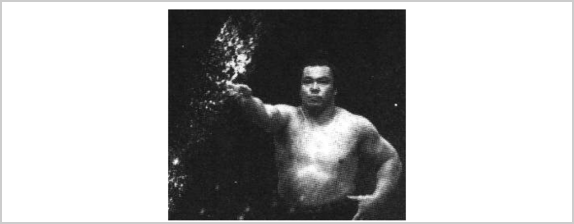
塩と日本人"相撲"力士の種まき
Japanese "sumo" wrestler sowing with salt
彼らは戦いの前に日本の"相撲"力士は塩を土俵にまく。彼らは塩をまくなぜヨーロッパやアメリカの人々が疑問に思う。しかし、ラビトケイヤーはユダヤ人はすぐにその意味を理解していることを書いた。
Japanese "sumo" wrestlers sow the sumo ring with salt before they fight. European or American people wonder why they sow salt. But Rabbi Tokayer wrote that Jews quickly understand its meaning.
日本人は塩に彼らが宗教的な提供を行うたびに提供する、これがイスラエルで使用されるのと同じ習慣です:
"すべての製品を使用すると、塩を提供しなければならない。 " (レビ記2時13分)
Japanese people offer salt every time they perform a religious offering, This is the same custom used by the Israelites:
"With all your offerings you shall offer salt." (Leviticus 2:13)
昔の日本の人々は彼らの赤ちゃんの最初のお風呂に塩を入れてのカスタムを持っていた。古代イスラエル人は塩(エゼキエル16時04 )でそっと赤ちゃんをこすった後、水で生まれたばかりの赤ちゃんを洗った。塩および/または水と聖化とクレンジングは、日本と古代イスラエルの両方の間で共通の習慣です。
Japanese people in old times had the custom of putting some salt into their baby's first bath. The ancient Israelites washed a newborn baby with water after rubbing the baby softly with salt (Ezekiel 16:4). Sanctification and cleansing with salt and/or water is a common custom among both the Japanese and the ancient Israelites.
ヘブライ語聖書では、 "クリーン"と "汚れた"という言葉は頻繁に表示されます。欧米人は、この概念に慣れていないですが、日本人はそれを理解しています。神道の中心的な概念は、値清浄にし、汚れを避けるために。この概念は、おそらく古代イスラエルから来ました。
In the Hebrew Scriptures, the words "clean" and "unclean" often appear. Europeans and Americans are not familiar with this concept, but the Japanese understand it. A central concept of Shinto is to value cleanness and to avoid uncleanness. This concept probably came from ancient Israel.
ユダヤ教と同様に、日本の神道の宗教ではありませんがアイドルではありません
Similar to Judaism, in Japanese Shinto Religion, There Are No Idols
仏教寺院は仏と他の神の形に刻まれている偶像を持っている。しかし日本の神社では、ない偶像はありません。
神社の聖なる場所の中央には、鏡、剣、またはペンダントがあります。それにもかかわらず、神道の信者は彼らの神として、これらのアイテムを捉えていない。神社では、神は不可視であると考えられている。鏡、剣、そしてペンダントはアイドルではありませんが、単にオブジェクトは、それが目に見えない神々が降りてくる神聖な場所であることを示すために。
Buddhist temples have idols which are carved in the shape of Buddha and other gods. However in Japanese Shinto shrines, there are no idols.
In the center of the Holy of Holies of a Shinto shrine, there is a mirror, sword, or pendant. Nevertheless, Shinto believers do not regard these items as their gods. In Shinto, gods are thought to be invisible. The mirror, sword, and pendant are not idols but merely objects to show that it is a holy place where invisible gods come down.
古代イスラエルの契約の箱には、神の十戒、マナの瓶とアロンのロッドの石碑があった。これらは、アイドルではなかったが、オブジェクトは、それが目に見えない神が降りてくる神聖な場所だったことを示すために。同じことは、日本の神社にあるオブジェクトに関して言うことができる。
In the ark of the covenant of ancient Israel, there were stone tablets of God's Ten Commandments, a jar of manna and the rod of Aaron. These were not idols, but objects to show that it was the holy place where the invisible God comes down. The same thing can be said concerning the objects in Japanese shrines.
古い日本の言葉はヘブライ語の起源を持って。
Old Japanese Words Have Hebrew Origin.
ヨセフアイデルバーグ、日本の神社で何年も残って一度Japanandに来たユダヤ人は、と題する本書いた"日本人とイスラエルの失われた十部族を。 "彼は、多くの日本人の言葉は古代ヘブライ語に由来書いた。例えば、我々は、日本の" hazukashime(恥しみ) "不名誉や屈辱を意味すると言う。ヘブライ語では、それは" hadakハシェム" ( ;ジョブ40:12を参照してください名前をダウントレッド)です。発音両者の意味はほぼ同じである。
Joseph Eidelberg, a Jew who once came to Japanand remained for years at a Japanese Shinto shrine, wrote a book entitled "The Japanese and the Ten Lost Tribes of Israel." He wrote that many Japanese words originated from ancient Hebrew. For instance, we Japanese say "hazukashime" to mean disgrace or humiliation. In Hebrew, it is "hadak hashem" (tread down the name; see Job 40:12). The pronunciation and the meaning of both of them are almost the same.
私たちは、 "アンタ"はヘブライ語で同じである"あなた"を意味すると言う。古代日本では王は意味ヘブライ語 " malhuto "に由来する可能性が言葉"命"と呼ばれていました"彼の王国を。 "日本の天皇は"ミカド"と呼ばれていますこれは、ヘブライ語、 " migadol 、 "似ている"貴族"をエリアリーダーのための日本古来の言葉は、 "アガタ· nushi ; "である"アガタは、エリア"と " nushiリーダー"です""です" " 。ヘブライ語では、彼らは" aguda "と呼ばれて"鼻"。
We say "anta" to mean "you," which is the same in Hebrew. Kings in ancient Japan were called with the word "mikoto," which could be derived from a Hebrew word "malhuto" which means "his kingdom." The Emperor of Japan is called "mikado." This resembles the Hebrew word, "migadol," which means "the noble." The ancient Japanese word for an area leader is "agata-nushi;" "agata" is "area" and "nushi" is "leader." In Hebrew, they are called "aguda" and "nasi."
我々日本人のカウントは、 "一つは、二人は、 3 ... 10 、 "我々は時々言うとき:
When we Japanese count, "One, two, three... ten," we sometimes say:
"ひー、ふー、み、よー、いつ、むー、なな、や、 ここの 、 とう 。 "
"Hi, fu, mi, yo, itsu, mu, nana, ya, kokono, towo."
これは、伝統的な表現であるが、その意味は、それが日本人であると考えられてい不明です。
This is a traditional expression, but its meaning is unknown it is thought of as being Japanese.
これは、この式は日本古来の神道の神話に由来すると言われています。神話では、世界の太陽光を管理"アマテラス"と呼ばれる女性の神は、かつて天の洞窟に身を隠し、そして世界が暗くなった。その後、日本の歴史の中で最も古い本によると、 " Koyane "と呼ばれる司祭は洞窟の前に言葉で祈り、他の神の前で"アマテラス"は出てきたように。言葉が書かれていない祈りの中で述べていますが、伝説は"ひー、ふー、みー...." 、これらの言葉があったことを言う
It has been said that this expression originates from an ancient Japanese Shinto myth. In the myth, the female god, called "Amaterasu," who manages the world's sunlight, once hid herself in a heavenly cave, and the world became dark. Then, according to the oldest book of Japanese history, the priest called "Koyane" prayed with words before the cave and in front of the other gods to have "Amaterasu" come out. Although the words said in the prayer are not written, a legend says that these words were, "Hi, fu, mi...."
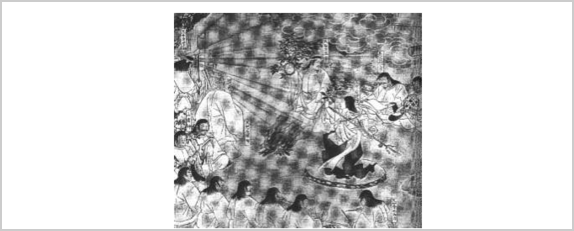
"アマテラス"は天の洞窟に隠れている"; Koyaneは"祈ってと "うずめ"は踊っています。
"Amaterasu" is hiding in a heavenly cave; "Koyane" is praying and "Uzume" is dancing
ヨセフアイデルバーグは、それが歴史を通していくつかの発音の変化があったと仮定した場合、これは、美しいヘブライ語の表現であることを述べた。これらの単語は綴られています:
" Hifaマイルyotsiaミリアンペアna'ne ykakhena tavo 。 "
Joseph Eidelberg stated that this is a beautiful Hebrew expression, if it is supposed that there were some pronunciation changes throughout history. These words are spelled:
"Hifa mi yotsia ma na'ne ykakhena tavo."
これは、意味: " (女神)美しい彼女をもたらす誰我々は彼女が来て誘惑する(コーラスで)何を呼び出す必要があります? "これは意外にも神話の状況に適合します。さらに、私達は日本人だけ" 、こんにちは、胡、マイル..."と言うだけでなく、同じ意味で言っていない:
This means: "The beautiful (Goddess). Who will bring her out? What should we call out (in chorus) to entice her to come?" This surprisingly fits the situation of the myth.
Moreover, we Japanese not only say, "Hi, hu, mi...," but also say with the same meaning:
"ひとつ、ふたつ、 みっつ 、 よっつ 、いつつ、 むっつ 、ななつ、 やっつ 、 ここのつ 、 とう 。 "
"Hitotsu, futatsu, mittsu, yottsu, itsutsu, muttsu, nanatsu, yattsu, kokonotsu, towo."
ここでは、 "東通"や "津"はそれぞれに置かれ、 "こんにちは、胡、マイル..."言葉の最後の部分として。しかし、最後の" towoは" (これは10を意味する)同じままです。 "東通"は "彼女は出てくる" 、を意味するヘブライ語" tetse 、 "ことができ、 "津"とはヘブライ語 "東証"かもしれない"出て来い。 "
Here, "totsu" or "tsu" is put to each of "Hi, hu, mi..." as the last part of the words. But the last "towo" (which means ten) remains the same. "Totsu" could be the Hebrew word "tetse," which means, "She comes out. " And "tsu" may be the Hebrew word "tse" which means "Come out."
アイデルバーグは、この言葉を司祭、囲まれ神々によって言われたことを信じて" Koyaneを。 " " Koyane "が最初に言うとき、それは"こんにちは、 "周囲の神々は、神々は"東通"の(追加、 "フー"、 " Koyane "が言う第二に返事で"東通" (彼女が出てくる) 、および追加、 、 、です達) 、などなど。このように、それは "ひとつ、ふたつ、 mittsu ...."となりました
Eidelberg believed that these words were said by the gods who surrounded the priest, "Koyane." That is, when "Koyane" first says, "Hi," the surrounding gods add, "totsu" (She comes out) in reply, and secondly, when "Koyane" says, "Fu," the gods add "totsu" (tatsu), and so on. In this way, it became "Hitotsu, futatsu, mittsu...."
しかし、最後の言葉は、 " towoは、 "司祭" Koyane "と周囲の神々は、一緒に言った。これはヘブライ語の単語である場合は" tavo 、 "それは " (彼女が)来る。 " 、意味彼らがこれを言うとき、女性の神は、 "天照大神は、 "出てきた。
However, the last word, "towo," the priest, "Koyane," and the surrounding gods said together. If this is the Hebrew word "tavo," it means, "(She) shall come." When they say this, the female god, "Amaterasu," came out.
"ひ、ふ、み..."と "ひとつ、ふたつ、みっつ ..."後で数をカウントする言葉として使用した。
また、僧侶の名前は、 " Koyaneは、 "、 " kohen 、 "どの手段、ヘブライ語に近い音"司祭"。アイデルバーグは、ヘブライ語の起源を持っているように見えた日本語の単語の多くの他の例を(数千)を示した。これは偶然ではないようです。
"Hi, fu, mi..." and "Hitotsu, futatsu, mittsu..." later were used as the words to count numbers.
In addition, the name of the priest, "Koyane," sounds close to a Hebrew word, "kohen," which means, "a priest." Eidelberg showed many other examples of Japanese words (several thousand) which appeared to have a Hebrew origin. This does not appear to be accidental.
日本古来の民謡では、多くの言葉は日本人として理解できていないように見える。博士英二Kawamoritaは、それらの多くはヘブライ語であることを考えた。熊本県における日本の民謡が歌われ、 "ハレルヤ、 haliya 、 haliya 、 tohse 、ヤハウェ、ヤハウェ、 yoitonnah ...."それはヘブライ語であるかのようにこれも聞こえる。
In ancient Japanese folk songs, many words appear that are not understandable as Japanese. Dr. Eiji Kawamorita considered that many of them are Hebrew. A Japanese folk song in Kumamoto prefecture is sung, "Hallelujah, haliya, haliya, tohse, Yahweh, Yahweh, yoitonnah...." This also sounds as if it is Hebrew.
聖書の系譜と日本の神話との間の類似性
Similarity Between the Biblical Genealogy and Japanese Mythology
聖書の記事と日本の神話との間に顕著な類似性があります。日本の学者は、日本神話に登場するニニギまわりの物語が大幅に聖書のヤコブのまわりの物語に似ていることを指摘している。
日本の神話では、大和のJapanand国民の皇室(日本人)は天から来たニニギからの子孫です。ニニギは、大和の部族、または日本語国民の祖先である。ヤコブはイスラエル人の祖先ですが。
There is a remarkable similarity between the Biblical article and Japanese mythology. A Japanese scholar points out that the stories around Ninigi in the Japanese mythology greatly resemble the stories around Jacob in the Bible.
In the Japanese mythology, the Imperial family of Japanand the nation of Yamato (the Japanese) are descendants from Ninigi, who came from heaven. Ninigi is the ancestor of the tribe of Yamato, or Japanese nation. While Jacob is the ancestor of the Israelites.
日本の神話では、天から下って来ていたニニギはありませんでしたが、他の。しかし、他に準備していた時、ニニギが生まれた、その結果では、代わりに彼のことを、ニニギは天から下って来て、日本の国民の祖先となった。同様に、聖書によれば、神の国になることだったが、結果には、代わりにエサウの、国民のための神の祝福をヤコブに与えられたエサウはヤコブの兄だった、とヤコブはの祖先となったイスラエル。
In the Japanese mythology, it was not Ninigi who was to come down from heaven, but the other. But when the other was preparing, Ninigi was born and in a result, instead of him, Ninigi came down from heaven and became the ancestor of the Japanese nation. In the same way, according to the Bible, it was Esau, Jacob's elder brother, who was to become God's nation but in a result, instead of Esau, God's blessing for the nation was given to Jacob, and Jacob became the ancestor of the Israelites.
ニニギが天から来た後に、日本語神話で、彼は此花咲夜姫という美しい女性と恋に落ち、彼女と結婚しようとしました。しかし、彼女の父親は彼女の姉も彼女だけでなく、結婚するために彼に尋ねたけど。しかし姉は醜いだったニニギは彼女の父に彼女の背中を与えた。同様に、聖書によれば、ヤコブは美しいレイチェルと恋に落ち、彼女の(創世記第29章)と結婚しようとしました。しかし、彼女の父親は、彼は兄の前に妹を与えることができないことをヤコブに言うので、彼はまた、姉(リア)が結婚することをヤコブに尋ねた。しかし姉はとても美しいではなかったが、ヤコブは彼女を嫌って。したがって、ニニギとジェイコブの間に並列処理があります。
And in the Japanese mythology, after Ninigi came from heaven, he fell in love with a beautiful woman named Konohana-sakuya-hime and tried to marry her. But her father asked him to marry not only her but also her elder sister. However the elder sister was ugly and Ninigi gave her back to her father. In the same way, according to the Bible, Jacob fell in love with beautiful Rachel and tried to marry her (Genesis chapter 29). But her father says to Jacob that he cannot give the younger sister before the elder, so he asked Jacob to marry the elder sister (Leah) also. However the elder sister was not so beautiful, Jacob disliked her. Thus, there is a parallelism between Ninigi and Jacob.
と日本の神話では、ニニギと彼の妻此花咲夜姫は、山幸·ヒコという名前の子を負うものとします。しかし、山幸·ヒコは、兄にいじめと海の神の国に行くことを持っています。山幸·ヒコがあり神秘的なパワーと彼に飢饉を与えることによって、トラブル兄を取得しますが、後で彼の罪を赦し。同様に、聖書によると、ヤコブと彼の妻レイチェルはヨセフという名前の子を負うものとします。
And in the Japanese mythology, Ninigi and his wife Konohana-sakuya-hime bear a child named Yamasachi-hiko. But Yamasachi-hiko is bullied by his elder brother and has to go to the country of a sea god. There Yamasachi-hiko gets a mystic power and troubles the elder brother by giving him famine, but later forgives his sin. In the same way, according to the Bible, Jacob and his wife Rachel bear a child named Joseph.
しかし、ヨセフは、彼の兄にいじめられ、エジプトに行かなくてはならなかったされています。そこヨセフはエジプトの総理大臣になり、権力を取得し、兄が原因で飢饉のエジプトに来たとき、ヨセフは彼らを助け、彼らの罪を赦し。したがって、山幸·ヒコとジョセフの間に並列性があります。
But Joseph is bullied by his elder brothers and had to go to Egypt. There Joseph became the prime minister of Egypt and gets power, and when the elder brothers came to Egypt because of famine, Joseph helped them and forgives their sin. Thus, there is a parallelism between Yamasachi-hiko and Joseph.
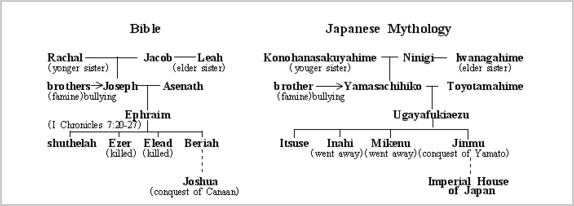
聖書の系譜と日本の神話との間の類似性
Similarity between the biblical genealogy and Japanese mythology
と日本の神話では、山幸·ヒコは、海の神の娘と結婚し、ウガヤ- fukiaezuという名前の子を産んだ。ウガヤ- fukiaezuは4人の息子を持っていた。しかし、彼の第二と第三の息子は、他の場所になくなっていた。前後の息子は神武天皇征服大和の地である。このラインでは、日本の皇室です。
And in the Japanese mythology, Yamasachi-hiko married a daughter of the sea god, and bore a child named Ugaya-fukiaezu. Ugaya-fukiaezu had 4 sons. But his second and third sons were gone to other places. The forth son is emperor Jinmu who conquers the land of Yamato. On this line is the Imperial House of Japan.
一方で、聖書の中でそれは何ですか?ヨセフはエジプトの司祭の娘と結婚し、マナセとエフライムを産んだ。エフライムはエフライムは4人の息子がいたという意味でウガヤ- fukiaezuに似ているが、彼の第二と第三の息子は、初期(1歴代誌7:20-27 )殺され、死亡した、前後の息子からの子孫は、カナンの地を征服したジョシュアだった(イスラエルの地) 。エフライムのライン上にイスラエルの10部族のロイヤルハウスです。
While, what is it in the Bible? Joseph married a daughter of a priest in Egypt, and bore Manasseh and Ephraim. Ephraim resembles Ugaya-fukiaezu in the sense that Ephraim had 4 sons, but his second and third sons were killed and died early (1 Chronicles 7:20-27), and a descendant from the forth son was Joshua who conquered the land of Canaan (the land of Israel). On the line of Ephraim is the Royal House of the Ten Tribes of Israel.
ニニギとジェイコブ、山幸·ヒコとジョセフの間に、日本の皇室とエフライムの部族 - こうして私たちは、聖書の系譜と日本の神話との間に顕著な類似性を見つける。
Thus we find a remarkable similarity between the biblical genealogy and Japanese mythology - between Ninigi and Jacob, Yamasachi-hiko and Joseph, and the Imperial family of Japan and the tribe of Ephraim.
さらに、日本の神話では、天は高間原(高間- GA-原または高間-NO-原)と呼ばれています。ニニギはそこから来て、日本の国家を設立しました。高間、 Zen'ichirou小矢部、日本人研究者のこの原に関しては、この、市内Haraninヤコブと彼の祖先がかつて住んでいたトガルマの領域であると考え、ヤコブはCanaanandに来た後、しばらくの間、トガルマのハランに住んでいた設立イスラエルの国家。
Furthermore, in the Japanese mythology, the heaven is called Hara of Takama (Takama-ga-hara or Takama-no-hara). Ninigi came from there and founded the Japanese nation. Concerning this Hara of Takama, Zen'ichirou Oyabe, a Japanese researcher, thought that this is the city Haranin the region of Togarmah where Jacob and his ancestors once lived; Jacob lived in Haran of Togarmah for a while, then came to Canaanand founded the Israeli nation.
ヤコブはかつて夢の中で、神の天使たちは、昇順と天とヤコブが彼の子孫は、カナンの地を継承するという神の約束を与えられた地球(創世記28:12 )の間に下降しました。これはニニギの天から降りて異なっていたが、画像に似ています。
Jacob once saw in a dream the angels of God ascending and descending between the heaven and the earth (Genesis 28:12), when Jacob was given a promise of God that his descendants would inherit the land of Canaan. This was different from Ninigi's descending from heaven, but resembles it in image.
このように、細部を除いて、日本の神話の輪郭が非常に聖書の記録に似ている。それは古事記と日本 - 日本書紀、 8世紀に書かれた日本の年代記の神話はもともと聖書の物語に基づいていますが、後で様々な異教の要素に追加されたことを考えることが可能である。でも、それは、日本の神話は、もともと日本人はヤコブ、ヨセフとエフライムからの子孫であることが示された系譜のようなものだったことを考えることが可能かもしれない。
Thus, except for details, the outline of the Japanese mythology greatly resembles the records of the Bible. It is possible to think that the myths of Kojiki and Nihon-shoki, the Japanese chronicles written in the 8th century, were originally based on Biblical stories but later added with various pagan elements. Even it might be possible to think that the Japanese mythology was originally a kind of genealogy which showed that the Japanese are descendants from Jacob, Joseph, and Ephraim.
月経とベアリングの間に子供不純物
Impurity during Menstruation and Bearing Child
月経とベアリング子間に汚れの概念は、古来から日本に存在しています。これは、月経中の女性は神社で神聖なイベントに出席するべきではないと昔から日本でカスタムされています。彼女は夫とセックスをすると彼女の月経と数日中または月経後7日程度の村のコラボレーション使用のために構築されている小屋(日本語Gekkei -ゴーヤと呼ばれる)に身を黙らなければならなかったことができませんでした。この習慣は、広く明治時代(約100年前)まで、日本では見られていた。端を彼女自身をシャットダウンの期間の後、彼女は自然の川のように水、春、または海によって自分自身をきれいにしなければならなかった。まだ天然水が存在しないこと、それが浴槽の中で行うことができる。
The concept of uncleanness during menstruation and bearing child has existed in Japan since ancient times. It has been a custom in Japan since old days that woman during menstruation should not attend holy events at shrine. She could not have sex with her husband and had to shut herself up in a hut (called Gekkei-goya in Japanese), which is built for collaboration use in village, during her menstruation and several days or about 7 days after the menstruation. This custom had been widely seen in Japan until Meiji era (about 100 years ago). After the period of shutting herself up ends, she had to clean herself by natural water as river, spring, or sea. It there is no natural water, it can be done in bathtub.
これは非常に古代イスラエルの習慣に似ている。古代イスラエルでは、月経中の女性は寺院で神聖なイベントに出席できなかった、彼女の夫から離れなければならなかった、そしてそれは(レビ記15:19 、月経後に彼女の月経、7日間、小屋に身をシャットアップするためのカスタムだった28 ) 。これは、自分自身をシャットダウンするまでの"彼女の浄化の血液中に継続する" 、これは精製のためだった、家や村から離れて不純物をすると言われた。
This resembles ancient Israeli custom very much. In ancient Israel, woman during menstruation could not attend holy events at the temple, had to be apart from her husband, and it was custom to shut herself up in a hut during her menstruation and 7 days after the menstruation (Leviticus 15:19, 28). This shutting herself up was said "to continue in the blood of her purification", and this was for purification and to make impurity apart from the house or the village.

Falasha 、エチオピアのユダヤ人によって使用される月経小屋
Menstruation hut used by Falasha, Ethiopian Jews
これは今日でも真実のまま。全く性的関係は、月経の日と追加の7日間、ありません。その後、女性はMikveh 、儀式の風呂に行きます。 Mikvehの水は天然水であることが必要です。雨水を収集しMikvehの浴槽にそれを置くのケースがあります。蛇口から十分な天然水、水を有しない場合で添加される。
This remains true even today. There are no sexual relations, for the days of menstruation and an additional 7 days. Then the woman goes to the Mikveh, ritual bath. The water of the Mikveh must be natural water. There are cases of gathering rainwater and putting it to the Mikveh bathtub. In case of not having enough natural water, water from faucet is added.
現代人は、この概念についての不合理を感じるかもしれないが、月経やベアリング子のニーズの間に女性は肉体的にも精神的に休む。女性自身が、彼女は時代の彼女の血液中の不純な感じと言っています。 "彼女の浄化の血液中に継続するには、 "彼女の血の残りの部分、この必要性を指します。
Modern people may feel irrational about this concept but women during menstruation or bearing child need rest physically and mentally. Woman herself says that she feels impure in her blood in the period. "To continue in the blood of her purification" refers to this need of rest of her blood.
月経に関わるだけでなく、日本の神道にベアリング子に関する概念は、古代イスラエルの一つに似ているだけではなく。
Not only concerning menstruation, but also the concept concerning bearing child in Japanese Shinto resembles the one of ancient Israel.
子どもを産んだ母親は、一定期間内に汚れたとみなされます。この概念は、日本人の間で、今日は弱いですが、昔は非常に一般的でした。古い神道の本、延喜式には、 ( 10世紀CE) 、彼女が子供を産んだ後、彼女は神聖なイベントに参加できないことを期間として7日に設定。聖書は女性が考案し、男性の子供を負担したときに、その後、彼女は"汚れた7日間"でなければならないと言うためにこれは、イスラエルの古代の習慣に似ている。
A mother who bore a child is regarded unclean in a certain period. This concept is weak among the Japanese today, but was very common in old days. The old Shinto book, Engishiki (the 10th century C.E.), set 7 days as a period that she cannot participate in holy events after she bore a child.
彼女はその後、 "彼女の浄化33日の血液中に継続"しなければならない。彼女は女性の子を負担した場合には、その後、彼女は、 "汚れた二週間"としなければならない、と彼女は"彼女の浄化の血66日間で続ける" "しなければならない(レビ記12:2-5 ) 。
This resembles an ancient custom of Israel, for the Bible says that when a woman has conceived, and borne a male child, then she shall be "unclean 7 days". She shall then "continue in the blood of her purification 33 days". In the case that she bears a female child, then she shall be "unclean two weeks", and she shall "continue in the blood of her purification 66 days'" (Leviticus 12:2-5).
日本ではそれは広く妊娠中および子を冠した後に女性が小屋(日本語でウブ-ゴーヤと呼ばれます)で自分自身をシャットダウンして、そこに住んでいたことが、明治時代までは見られていた。彼女は(最長の場合はほぼ100日であった)の子を産んだ後に期間が妊娠し、30日かそこらの間に通常だった。これは、古代イスラエルの習慣に似ている。
In Japan it had been widely seen until Meiji era that woman during pregnancy and after bearing child shut herself up in a hut (called Ubu-goya in Japanese) and lived there. The period was usually during the pregnancy and 30 days or so after she bore a child (The longest case was nearly 100 days). This resembles the custom of ancient Israel.
古代イスラエルにおいて、精製のこの期間の後母が初めて彼女の子供を持つ寺に来ることができました。また、日本の神道の習慣では、浄化のこの期間の後に母親が赤ちゃんと一緒に神社に来ることができます。彼女は男性の場合には赤ちゃんを産んだ後に現代の日本では、一般的に32日(または31日)であり、女性の場合は33日。
In ancient Israel, after this period of purification the mother could come to the temple with her child for the first time. Also in the custom of Japanese Shinto, after this period of purification the mother can come to the shrine with her baby. In modern Japan it is generally 32 days (or 31 days) after she bore the baby in case of a male, and 33 days in case of a female.
しかし、彼らは神社に来たとき、それが赤ちゃんを運ぶ母ではありません。これは、赤ちゃんが母親であるが、通常、夫の母親(姑)で行われるべきではないという伝統的な習慣である。これは、古代イスラエルのカスタムで、出産後、純度と母の不純物の顕著な類似性である。
But when they come to the shrine, it is not the mother who carries the baby. It is a traditional custom that the baby should be carried not by the mother, but usually by the husband's mother (mother-in-law). This is a remarkable similarity of purity and impurity of the mother, after childbirth, with ancient Israeli custom.
日本人" Mizura "とユダヤ人Peyot
Japanese "Mizura" and Jewish Peyot
下の写真(左)は奈良、日本では5世紀後半CEの遺物で見つかった古代の日本の侍の像です。この像は、現実的に髪が彼の帽子の下に降りてくると、いくつかのカーリングと両耳の前にハングアップ" mizura 、 "と呼ばれる古代の日本人男性のヘアスタイルを示しています。このヘアスタイルは、広く日本の武士の間で見られ、それは、中国や韓国の文化から来た1日本特有ではなかった。
The photo below (left) is a statue of an ancient Japanese Samurai found in relics of the late 5th century C.E. in Nara, Japan. This statue shows realistically the ancient Japanese men's hair style called "mizura," which hair comes down under his cap and hangs in front of both ears with some curling. This hair style was widely seen among Japanese Samurais, and it was unique to Japan, not the one which came from the cultures of China or Korea.
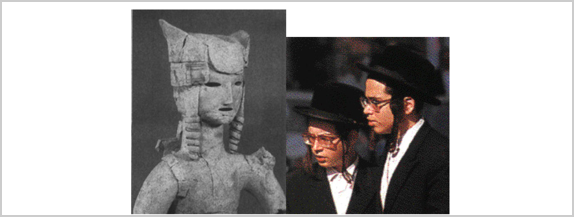
古代日本の侍のヘアスタイル"mizura"(左)とユダヤ人"peyot"(右)
Ancient Japanese Samurai's hair style "mizura" (left) and Jewish "peyot" (right)
それは、これはまた、いくつかのカール(写真右)と長い耳の前に髪をぶら下げのヘアスタイルである非常にユダヤ人の"peyot"(パイヨ)、似ていることは単なる偶然では? "Peyotは、"ユダヤ人のためのユニークなヘアスタイルで、起源は非常に古いです。聖書のレビ記19:27言及:"'は、あなたの頭の両側に髪をカットしないでください。"
Is it a mere coincidence that this resembles Jewish "peyot" (payot) very much, which is also a hair style of hanging the hair in front of the ears long with some curling (photo right)? "Peyot" is a unique hair style for Jews and the origin is very old. Leviticus 19:27 of the Bible mentions:
"'Do not cut the hair at the sides of your head."
だから、この習慣は古代イスラエルから発信。今日のハシドのユダヤ人の"peyot"カスタムは、この古代のカスタムの回復である。イエメンのユダヤ人は古来、このカスタムを持っていた。 8日または9世紀BCEからのものであるシリアからの像があります。それはpeyotと縁取られたショールとヘブライ語の男性を示しています。
So, this custom originated from the ancient Israelites. The "peyot" custom of today's Hasidic Jews is a recovery of this ancient custom. Yemenite Jews have had this custom since ancient times. There is a statue from Syria, which is from the 8th or 9th century B.C.E.. It shows a Hebrew man with peyot and a fringed shawl.
日本人とユダヤ人上のDNA研究
DNA Research on the Japanese and Jews
DNAは、日本人とユダヤ人の共通の祖先を示しています
DNA shows the common ancestry of the Japanese and Jews
Y染色体に関する最近のDNA研究は日本人の約40 %はハプログループDのY染色体DNAのDNAを持っていることを示したが、父から息子に渡され、へTから"ハプログループ"と呼ばれる遺伝子のグループに遺伝的特徴に応じて分類されている。世界で唯一の日本人とチベットの人々は、高い周波数でハプログループDを持っている。 Dは滅多にさえ、中国と韓国の間で発見されていません。
Recent DNA researches on Y-chromosome showed that about 40 % of the Japanese have DNA of haplogroup D. Y-chromosome DNA is passed from father to son, and is classified according to genetic features into genetic groups called “haplogroups” from A to T. Only Japanese and Tibetan peoples in the world have haplogroup D at a high frequency. D is rarely found even among the Chinese and Koreans.
遺伝学者によると、ハプログループDは、全世界のユダヤ人のグループに含まれていますハプログループEの同胞である。ハプログループDとEは、かつて1だったとウィキペディア百科事典状態として、共通の起源を持っている:"ハプログループEとともに、 Dが彼らの共通の祖先を示す独特のYAP多型が含まれています" [ハプログループD (Y -DNA )が]
According to geneticists, haplogroup D is the compatriot of haplogroup E, which is found in all Jewish groups of the world. Haplogroups D and E were once one and have the common origin, as Wikipedia encyclopedia states:
“Along with haplogroup E, D contains the distinctive YAP polymorphism, which indicates their common ancestry.” [Haplogroup D (Y-DNA)]
ファミリーツリーのDNA、 DNAテストプロバイダ、ハプログループEの特にE1b1b1種類によると、 "アシュケナージ、セファルディ、クルド人、イエメン、サマリア人もジェルバのユダヤ人グループの中から、すべてのユダヤ人の集団で発見した。 "です彼らは見つけるために、この遺伝子マーカーを使用ユダヤ人の子孫。
According to Family Tree DNA, a DNA test provider, especially E1b1b1 type of haplogroup E is “found in all Jewish populations, from Ashkenazi, Sephardic, Kurdish, Yemen, Samaritan and even among Djerba Jewish groups.” They use this genetic marker to find Jewish descendants.
イスラエルの失われた部族の子孫であると言われているアフガニスタンやパキスタンでPathansは、著しくハプログループEを持っている。また、失われた部族からであると言われているウズベキスタンのユダヤ人は、 28%の頻度でハプログループEを持っている。 Falasha 、エチオピアのユダヤ人は、 50%で、ハプログループEを持っている。ハプログループEは、イスラエルの失われた部族からであると言われたものの中であっても発見された。
The Pathans in Afghanistan and Pakistan, who are said to be descendants of the Lost Tribes of Israel, have haplogroup E remarkably. The Uzbekistan Jews, who are also said to be from the Lost Tribes, have haplogroup E at the frequency of 28 %. The Falasha, Ethiopian Jews, have haplogroup E at 50 %. Haplogroup E is found even among those said to be from the Lost Tribes of Israel.
ハプログループDとEは、かつて1であったが、近東で別個になった。東へ移動した人は含めて? "イスラエルチベット"と日本、東アジア、イスラエルの失われた部族となった一方近東に残ったり、西に行った人たちは、ユダヤ人となった。
Haplogroups D and E were once one, but became separate in the Near East. Those who remained in the Near East or went west became Jews, while those who moved east became the Lost Tribes of Israel in the East, including”Israelite Tibetans” and the Japanese.
私が呼んで、 "イスラエルのチベット人は"チェンマイ(強)の人(中国南西部) 、 Shinlung (ブネイMenasheの、北東インド)とカレン(ミャンマー)である。彼らはすべてのチベットの近くに住んでいるとチベット·ビルマ語群の言語を話す。 AmishavのラビエリヤフAvichail 、彼らは多くの古代イスラエルの習慣を持っているので、これらの部族は、失われた部族の子孫であると思います。これは、チェンマイの人々の、特に23%は日本人、またハプログループDを有する密接にそれらに関連しているE.との共通祖先から来たハプログループDを持っていることは注目に値する。
What I call “Israelite Tibetans” are the Chiang (Qiang) people (southwest China), the Shinlung (Bnei Menashe, northeast India) and the Karen (Myanmar). They all live near Tibet and speak language of Tibet-Burma language group. Rabbi Eliyahu Avichail of Amishav thinks that these tribes are descendants of the Lost Tribes, because they have many ancient Israeli customs. It is noteworthy that especially 23% of the Chiang people have haplogroup D, which came from the common ancestor with E. The Japanese, having haplogroup D also, are closely related to them.
ラビAvichail 、彼らすべてがかつて、中国でさまよった中国人によって迫害されたと同じ伝説や習慣を持って、そこに律法を失ったため、これらのチェンマイ、 Shinlungとカレンは、一度一つの同じ部族であったと思います。それは日本人の起源とこれらイスラエルチベット人がかつて同じだったようだ。
Rabbi Avichail thinks that these Chiang, Shinlung and Karen were once one and the same tribe, because they all once wandered in China, were persecuted by the Chinese and lost the Torah there, having the same legends and customs. It seems that the origins of the Japanese and these Israelite Tibetans were once the same.
現在のユダヤ人は、アシュケナージとセファルディの両方が、主にそれは、古代のユダヤ人は、主にハプログループJとEを持っていたと考えられているハプログループJ、 EとRを持っている
Current Jews, both Ashkenazi and Sephardic, mainly have haplogroups J, E and R. It is thought that ancient Jews mainly had haplogroups J and E.
一部の人々は約80 %が父性しかしJに大祭司アロンの子孫であるコーエンファミリ、属するを継承しているため、特にJは、元ユダヤ人特有だったと思い、アーロンはレビ人で、 Jは父方のレビ人の間で発見されている場合のみ比較的低い周波数で。他のユダヤ人がそうであるようにレビ人は、ハプログループEを持ち、サマリア人レビ人の祭司たちはハプログループEのハプログループEに属しているが、世界のすべてのユダヤ人のグループで発見され、Eは70 CEのディアスポラ前から独特のユダヤ人のハプログループであった。
Some people think that especially J was peculiar to original Jews, because about 80% of paternally inherited Cohen families, who are descendants of the High Priest Aaron, belong to J. However, Aaron was a Levite, and J is found among paternal Levites only at a relatively low frequency. The Levites have haplogroup E as other Jews do, and Samaritan Levite priests belong to haplogroup E. For haplogroup E is found in all Jewish groups of the world, E had been a distinctive Jewish haplogroup since before the diaspora of 70 C.E..
イスラエル人は非常に初期の時代から経験豊かな混合血を持っていた。聖書(出エジプト記12:38 、新世紀版) "イスラエル人ではなかった他の多くの人々がそれらと一緒に行った" 、エジプトからの脱出について言及している。モーセ何度も、彼の人々の間で生きている外国人について言及した。彼らはイスラエル人になる可能性があれば割礼とイスラエル(出エジプト記12時48分、等)として生きている。古代イスラエル人の中にあるいくつかのハプログループは、このようにありました。
Israelites had experienced blood mixing since very early times. The Bible mentions about the exodus from Egypt, "Many other people who were not Israelites went with them" (Exodus 12:38, New Century Version). Moses many times mentioned about foreigners living among his people. They could become Israelites if circumcised and living as Israelites (Exodus 12:48, etc). There were thus some haplogroups found among ancient Israelites.
しかし、イスラエルの失われた部族からのものと言われている人々のほとんどは、以下の人々を含む、ハプログループJを、持っていない:
However, most of the peoples who are said to be from the Lost Tribes of Israel do not have haplogroup J, including the following peoples:
チェンマイ(強、中国南西部)
Chiang (Qiang, southwest China)
ブネイMenasheの( Shinlung 、北東インド)
Bnei Menashe (Shinlung, northeast India)
カレン(ミャンマー)
Karen (Myanmar)
ベーネエフライム(南インド)
Bene Ephraim (South India)
ベータイスラエル( Falasha 、エチオピア)
Beta Israel (Falasha, Ethiopia)
Bukharanユダヤ人(ペルシャのユダヤ人)
Bukharan Jews (Persian Jews)
イボユダヤ人(ナイジェリア)
Igbo Jews (Nigeria)
日本人はまた、ハプログループJ.それは古代イスラエル人の基本的なハプログループは、ハプログループEまたはハプログループDE (ハプログループDとEの祖先)であったと思われていない。今日、西アジアや中央アジアにおけるイスラエルの生活ロスト部族ですPathansとウズベキスタンのユダヤ人が、東にある間ハプログループE.を持って、チェンマイと日本人はハプログループDを持っている。
DとEは、かつて1だった。日本人はイスラエルの失われた部族から遺伝的にある。
The Japanese also do not have haplogroup J. It seems that the basic haplogroup of ancient Israelites was haplogroup E or haplogroup DE (ancestor of haplogroups D and E). Today, the Pathans and Uzbekistan Jews, who are the Lost Tribes of Israel living in West Asia or Central Asia, have haplogroup E. While in the East, the Chiang and the Japanese have haplogroup D.
D and E were once one. The Japanese are genetically from the Lost Tribes of Israel.
に継続するために:To be continued to:
第2章 - アフガニスタン、パキスタン、カシミール、ミャンマーにおけるイスラエルの失われた十部族、そして中国
Chapter 2 - The Ten Lost Tribes of Israel in Afghanistan, Pakistan, Kashmir, Myanmar, and China
第3章 - イスラエルの失われた部族が古代日本に来ましたか?
Chapter 3 - Did the Lost Tribes of Israel Come To Ancient Japan?
第4章 - 古代イスラエルと古代日本の間の様々な他の類似点
Chapter 4 - Various Other Similarities Between Ancient Israel and Ancient Japan
あなたの個人的な使用のためにこのサイトを印刷し、あなたの友人にそれを配布すること自由に感じなさい。
Please feel free to print this site for your personal use, and distribute it to your friends.
有正久保 / Arimasa Kubo
http://www5.ocn.ne.jp/~magi9/isracame.htm
レムナント出版
Eメール: (私は全員に返信することはできないかもしれませんが自分の考えや意見は、歓迎されている)
ホーム·ページはこちらです。
詳細については、 / For more information
日本とユダヤのハーモニー
日本に潜むユダヤの痕跡
